AMD Radeon R9 290X Review

Finally we can tell about Radeon R9 290X performance. The top AMD graphics card is competing now with very powerful rivals: Nvidia GeForce GTX 780 and GeForce GTX 780 Ti.
AMD’s flagship Radeon R9 290X graphics card with the new Hawaii XT core was released a few months ago. Since then there have been released several beta and one official version of the Catalyst driver suite that were supposed not only to improve the new Radeon’s performance but also optimize its cooling and noise parameters which had been criticized in early reviews.
The graphics card market has changed, too. Nvidia seems to have been prepared for AMD’s Radeon R9 290X/290 release, so besides cutting the price of the GeForce GTX 780 and GTX 770 they rolled out the faster GeForce GTX 780 Ti. The market situation for nearly all of the Radeons has also been worsened by the cryptocurrency craze. Coupled with the traditional Christmas excitement, it has provoked a considerable rise in prices and even shortage of AMD-based products. So the bottom price of a reference Radeon R9 290X is about one fourth higher than the price of an original GeForce GTX 780 with high-efficiency cooler and factory overclocking as of the time of our writing this.
Anyway, AMD fans don’t lose hope that the prices will stabilize and the shortage will end. We are also looking forward to getting original versions of AMD’s new cards with better and quieter coolers. Until then we have to content ourselves with testing the reference Radeon R9 290X and comparing it with its current market opponents using new drivers and an extended set of benchmarks.
Specifications and Recommended Price
The following table helps you compare the AMD Radeon R9 290X specifications with the reference versions of AMD Radeon R9 280X, Nvidia GeForce GTX 780 and Nvidia GeForce GTX 780 Ti:
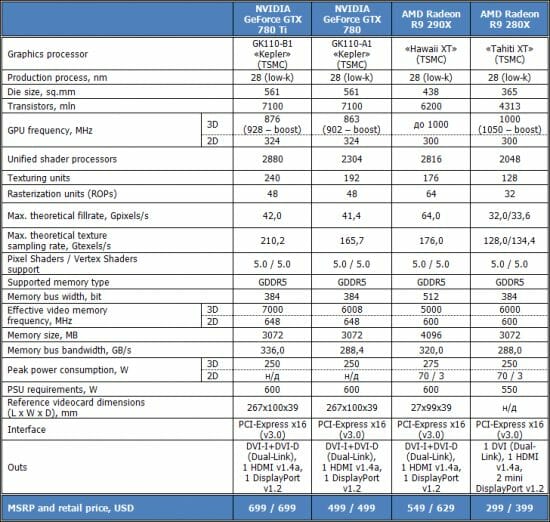
This review has been late due to the sheer lack of test samples, so we won’t delve into details about the architectural differences of the new GPU and the whole graphics card from their predecessors. Suffice it to say that the new Hawaii XT features the same Graphics Core Next architecture as the Tahiti XT but has more muscle. To be specific, it incorporates 2816 instead of 2048 unified shader processors, 176 instead of 128 texture-mapping units, and 64 instead of 32 raster operators. Still manufactured on 28nm tech process, the GPU consists of about 6.2 billion transistors (instead of 4.313 billion) and has grown in size from 365 to 438 sq. mm. The clock rate has remained the same at 1000 MHz (in 3D mode). The memory frequency is lower compared to the Radeon HD 7970 GHz Edition: 5000 vs. 6000 MHz. However, the memory bus is 512-bit now, so the memory bandwidth has grown from 288 to 320 GB/s. Instead of 3 GB, the AMD Radeon R9 290X comes with 4 GB of onboard memory.
In the software department, the new Mantle API must be noted in the first place. It is supposed to minimize the effect of the API on the game engine code and reduce CPU load, yet its benefits are still debatable. Time will show how useful it really is. Besides it, we can note the DirectX 11.2 support, the exclusive TrueAudio technology and the well-known AMD Eyefinity feature.
PCB Design and Features
The new AMD Radeon R9 290X follows the classic dual-slot design where the face side of the PCB is covered by the cooling system with a radial fan. The device’s rather boring brick-like appearance is somewhat enlivened by a few sculpted red lines:
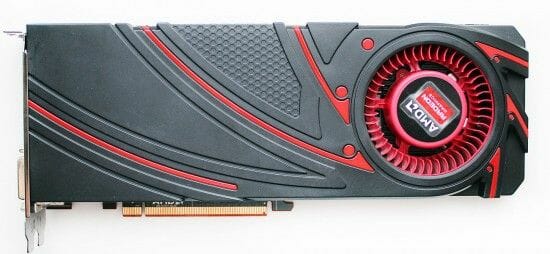
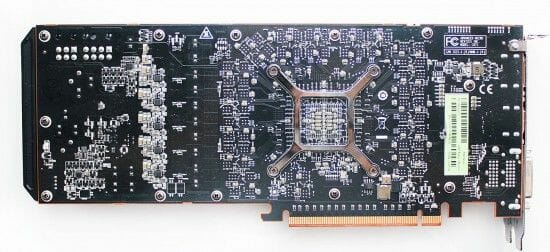
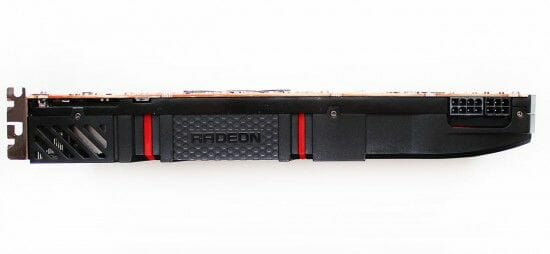
The card measures 275x99x39 mm. Its reverse side is exposed.
The AMD Radeon R9 290X has dual-link DVI-I and DVI-D outputs, one HDMI 1.4a connector and one DisplayPort version 1.2.
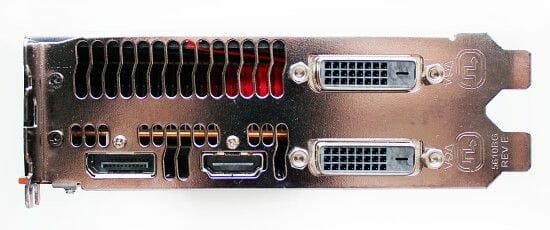
There’s a vent grid in the card’s mounting bracket to exhaust the hot air from the cooler out of the computer case.
As opposed to its predecessors, the new AMD Radeon R9 290X lacks CrossFireX connectors. Multi-GPU configurations are now built using the PCI Express bus.
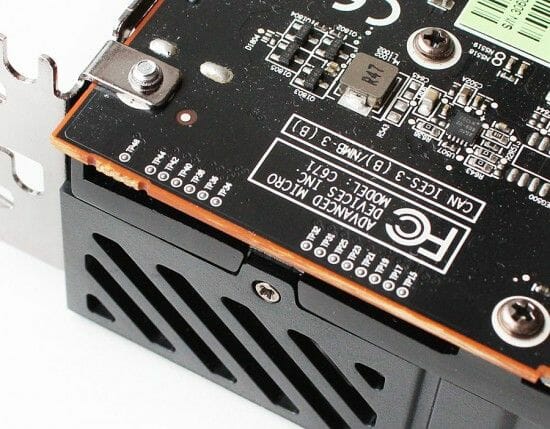
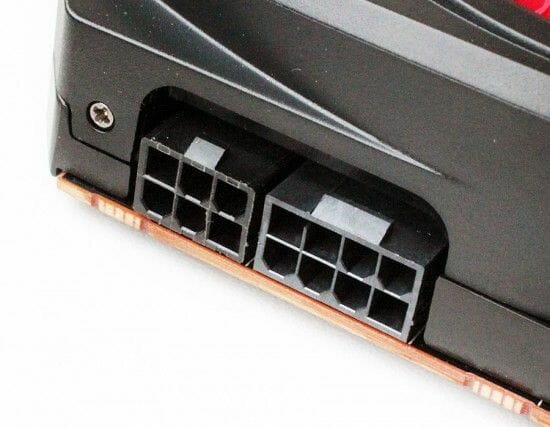
Additional power is delivered to the card via one 6-pin and one 8-pin connector. The peak power draw is specified to be 275 watts, which is a mere 25 watts more than required by the Radeon R9 280X.
A BIOS switch can be found in its traditional location:
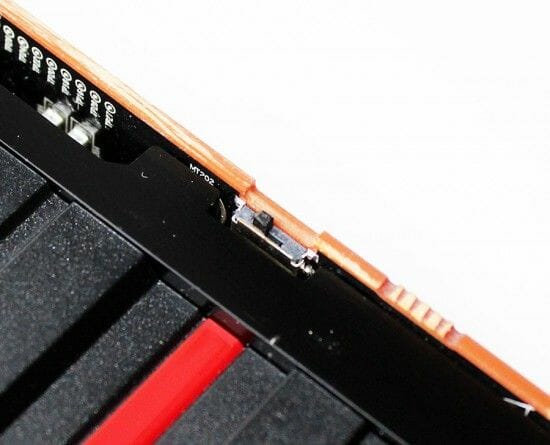
It allows booting from a different BIOS chip and choosing between two operation modes for the card’s cooler: Uber Mode and Quiet Mode. We’ll tell you more about them shortly in our description of the cooling system.
The PCB design is overall similar to that of the Radeon R9 280X and of the earlier Radeon HD 7970 GHz Edition:
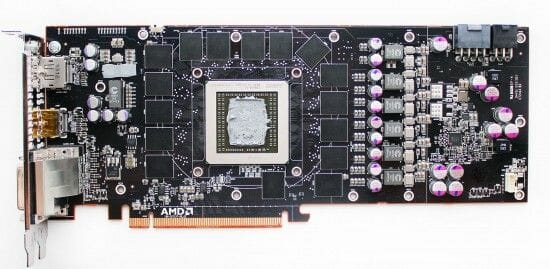
The power system includes 5 phases for the GPU, 1 phase for the memory, and 1 phase for PLL. It uses state-of-the-art DirectFET transistors.
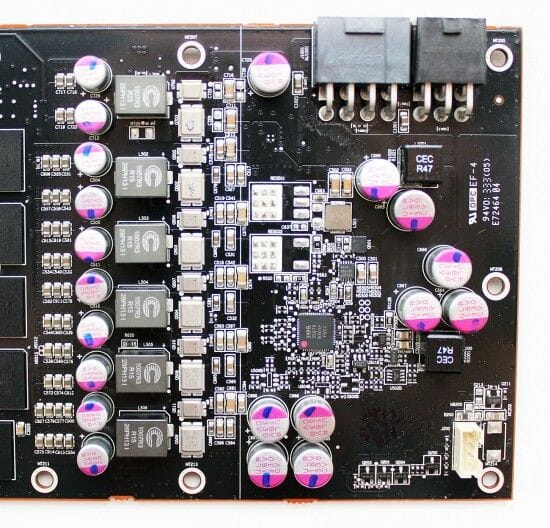
The GPU voltage regulator is based on an International Rectifier 3567B controller:
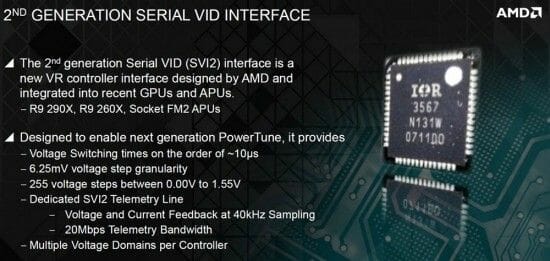
AMD puts an emphasis on it, claiming that the controller helps improve AMD’s PowerTune technology. The voltage regulator is 6.25 mV accurate now, so there are as many as 255 possible values in the range of 0 to 1.55 volts.
The GPU looks impressive with its 438 sq. mm die which is 20% larger than the Tahiti. Well, it is still smaller than the GK110 (561 sq. mm). Our sample of the GPU was manufactured on the 31st week of 2013 in Taiwan. Its marking is printed around the chip on the protective metal frame:
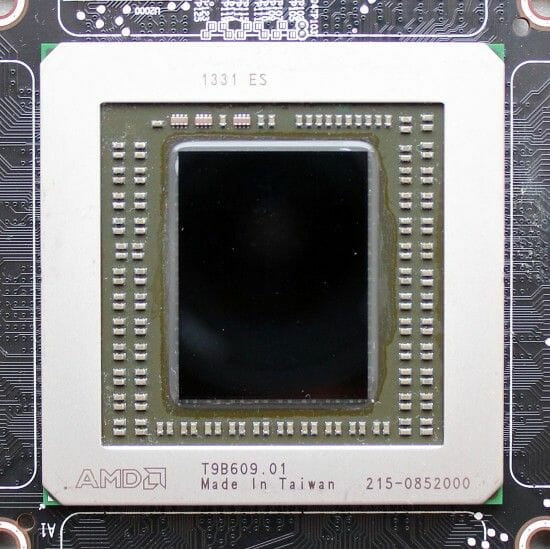
The GPU incorporates 2816 unified shader processors, 176 texture-mapping units, and 64 raster operators. It is expected to work at clock rates up to 1000 MHz in 3D applications, depending on load and temperature. The clock rate is dropped to 300 MHz in 2D mode while the voltage is lowered from 1.195 to 0.945 volts.
The ASIC quality is rather high for an engineering sample at 76.2%:
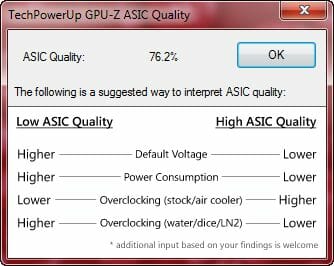
The card comes with 4 gigabytes of GDDR5 memory in FCBGA chips soldered to the face side of the PCB. These are H5GQ2H24AFR R0C components from SK Hynix:
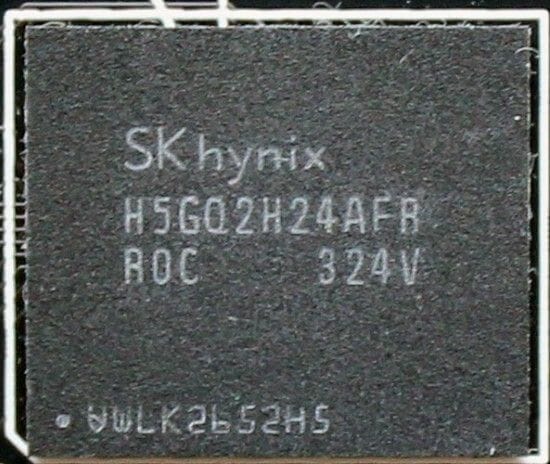
The chips are rated for 6000 MHz but clocked at 5000 MHz on the Radeon R9 290X, so we can expect them to overclock well. The memory bandwidth is anyway quite high with the 512-bit bus: 320 GB/s. That’s higher compared to the GeForce GTX 780 but somewhat worse compared to the GeForce GTX 780 Ti.
Thus, the Radeon R9 290X has the following specs:
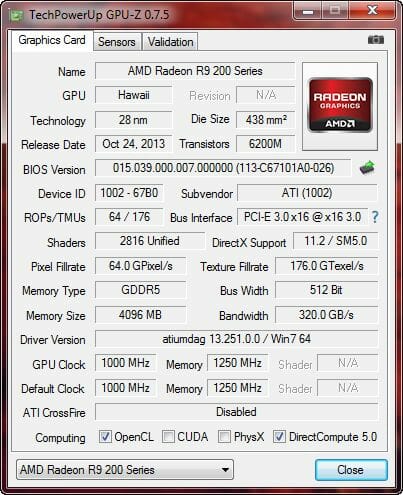
Now we can check out its cooling system, temperature and noisiness.
Cooling System: Efficiency and Noise Level
The AMD Radeon R9 290X is equipped with a cooler whose design hasn’t changed much since AMD’s earlier reference coolers. The plastic casing fastened with several screws around the base frame covers a large aluminum heatsink, a steel heat-spreading plate and a radial fan:
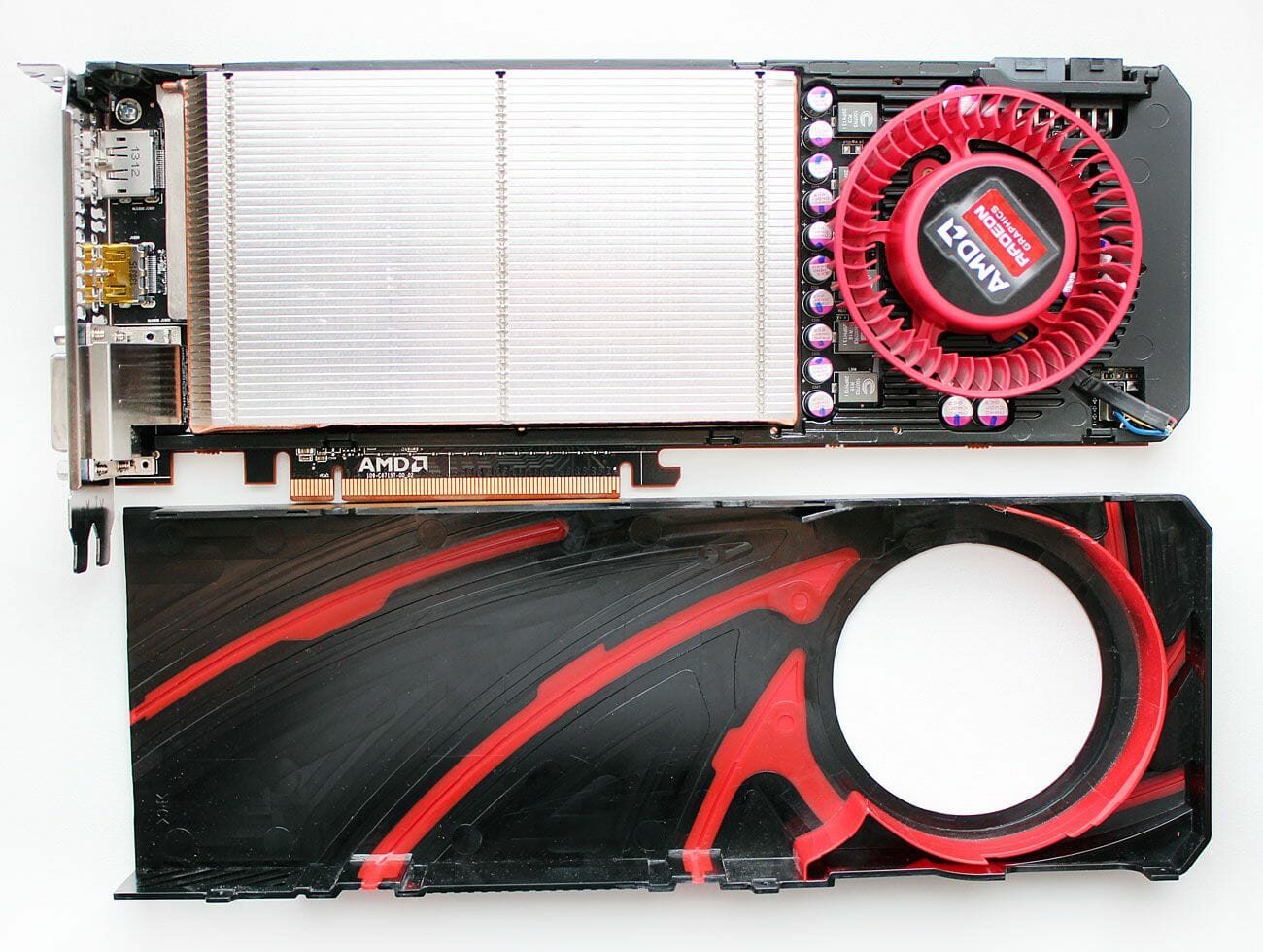
The heatsink is soldered to the base which has contact with the memory chips and power components via thermal pads.
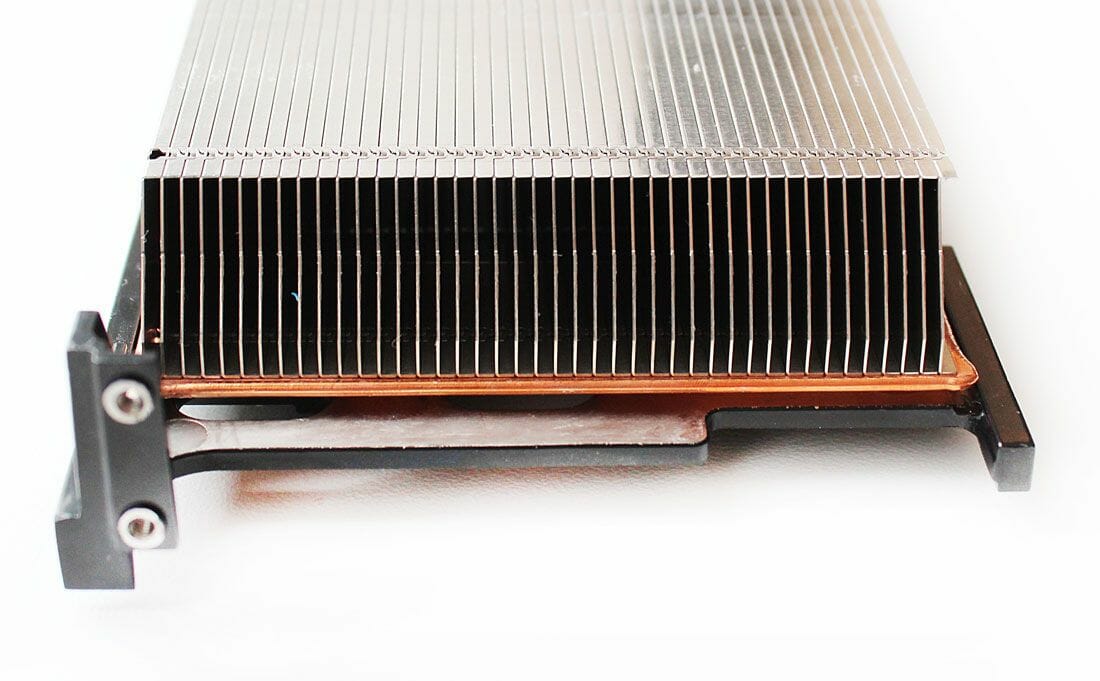
The heatsink consists of slim aluminum fins soldered to a copper base:
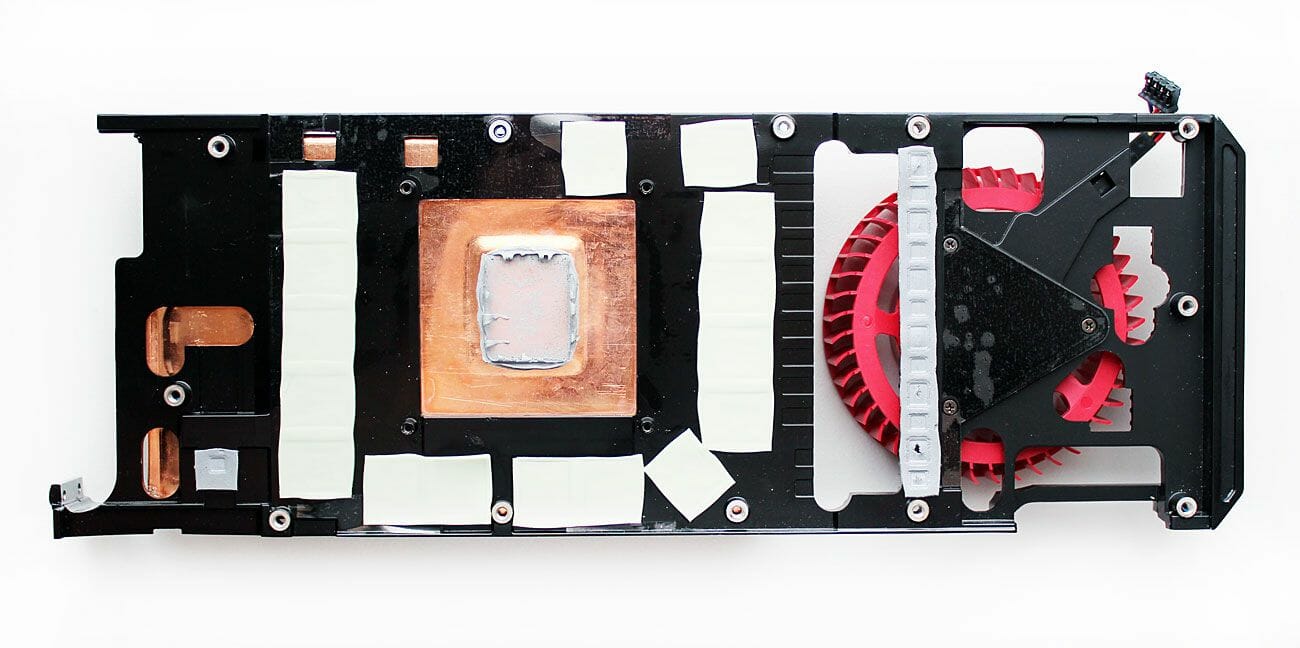
The base is a large vapor chamber with too much of thick and viscous thermal grease in the middle.
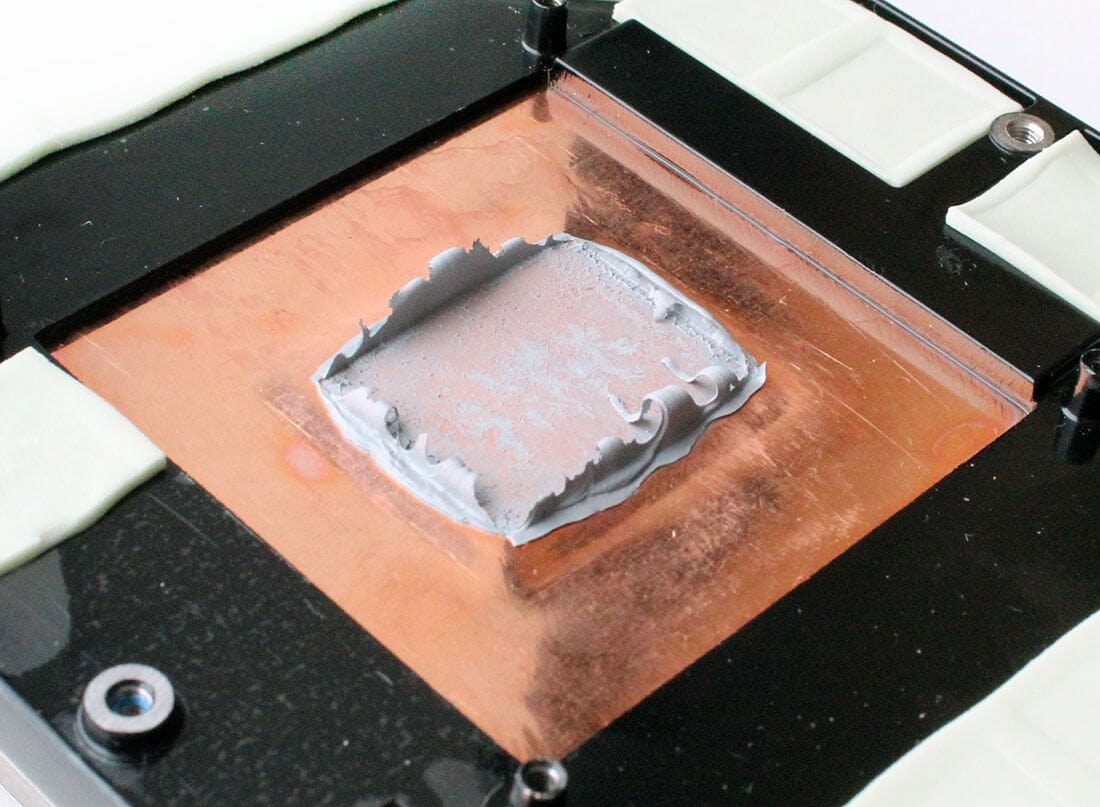
The fan drives the air through the heatsink and exhausts it out of the computer case. The 70mm blower is made by FirstD (the FD7525U12D model).
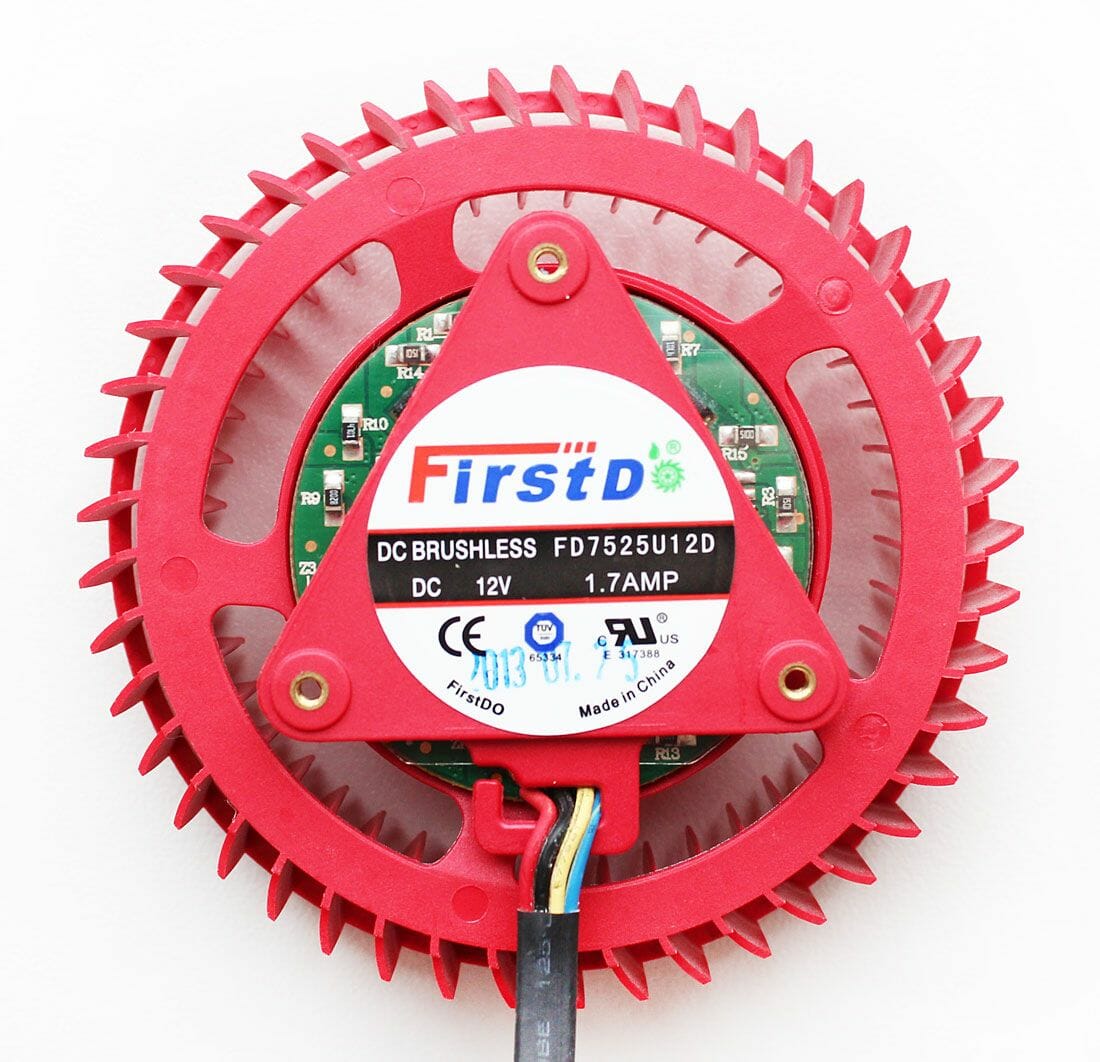
Its speed is PWM-regulated in a range of 1000 to 5500 RPM. The fan has a peak output power of 20.4 watts at 1.7 amperes.
To measure the temperature of the graphics card we ran Aliens vs. Predator (2010) five times at the maximum visual quality settings, at a resolution of 2560×1440 pixels, with 16x anisotropic filtering and with 4x MSAA.
We used MSI Afterburner 3.0.0 beta 17 and GPU-Z version 0.7.4 to monitor temperatures inside the closed computer case. The computer’s configuration is detailed in the following section of our review. All tests were performed at 25°C room temperature.
As we noted above, the reference Radeon R9 290X has two BIOS versions with different fan settings. There are two modes: Silent and Normal (or Quiet and Uber). They differ in how the fan’s speed depends on the GPU’s temperature and clock rate. Here’s what we have in the Silent mode during the looped Aliens vs. Predator test:
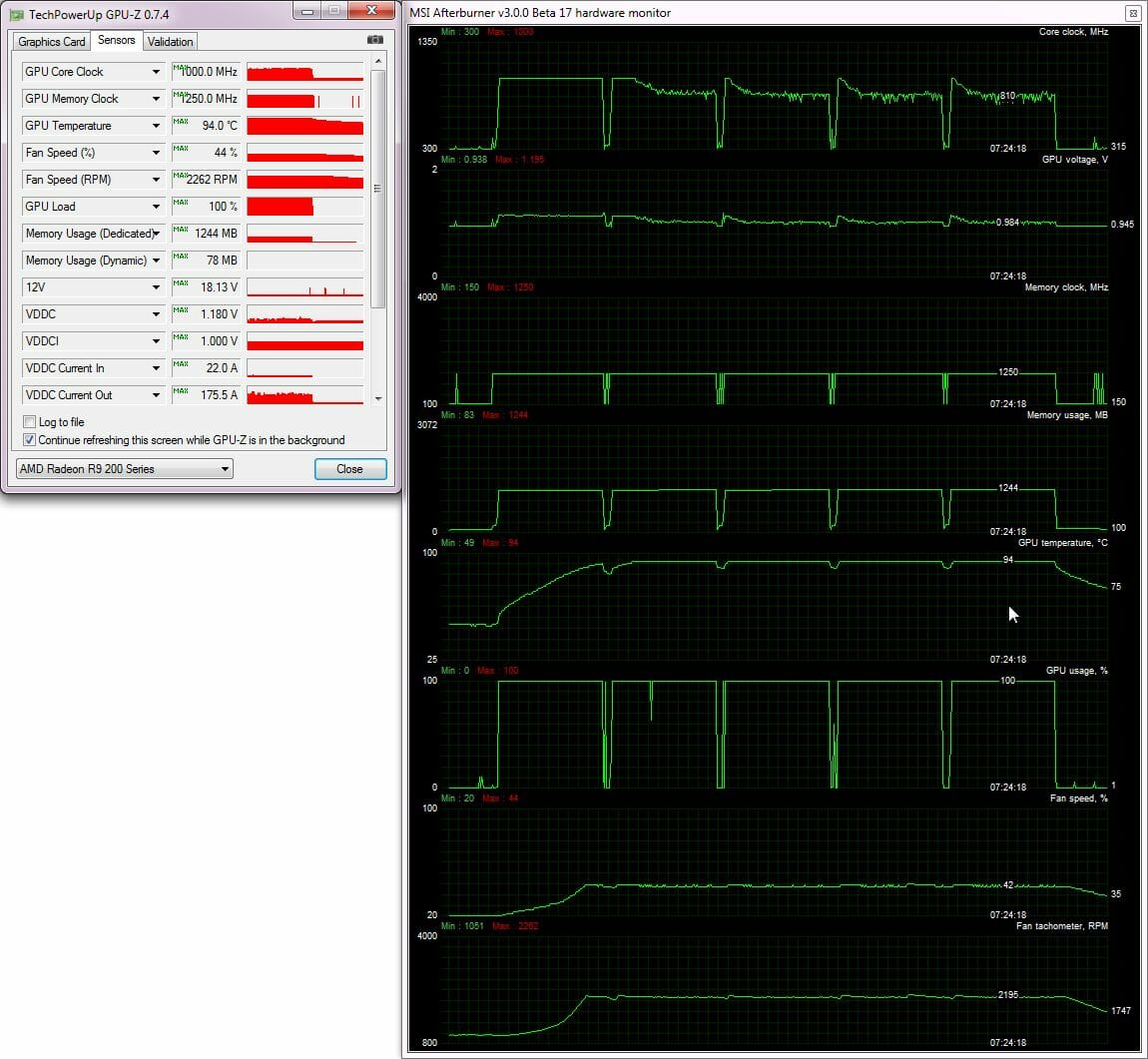
At the beginning of the second test cycle the GPU grew as hot as 94°C, triggering thermal throttling (similar to what was first implemented in Intel CPUs a few years ago). The clock rate was lowered whereas the speed of the fan didn’t exceed 2300 RPM (44% of the fan’s full power). Although the noise level is out of the comfort zone, AMD calls this mode quiet. Of course, the card’s performance is lower in this mode since the clock rate can drop down to 700 MHz, which is about 30% lower than the GPU’s default frequency. Thus, the reference design doesn’t seem to be attractive for practical purposes.
But the main problem is that when you switch to another BIOS and enable the Normal mode, the fan can accelerate up to 49% or 2800 RPM, which is still not enough to avoid the frequency drop. The GPU gets 94°C hot again, just not so quickly – during the fourth test cycle. That’s why we tried to find out the fan’s speed which would prevent the GPU from slowing down. We almost did it at 55% and 3020 RPM, yet the frequency would still sag down to 978 MHz occasionally:
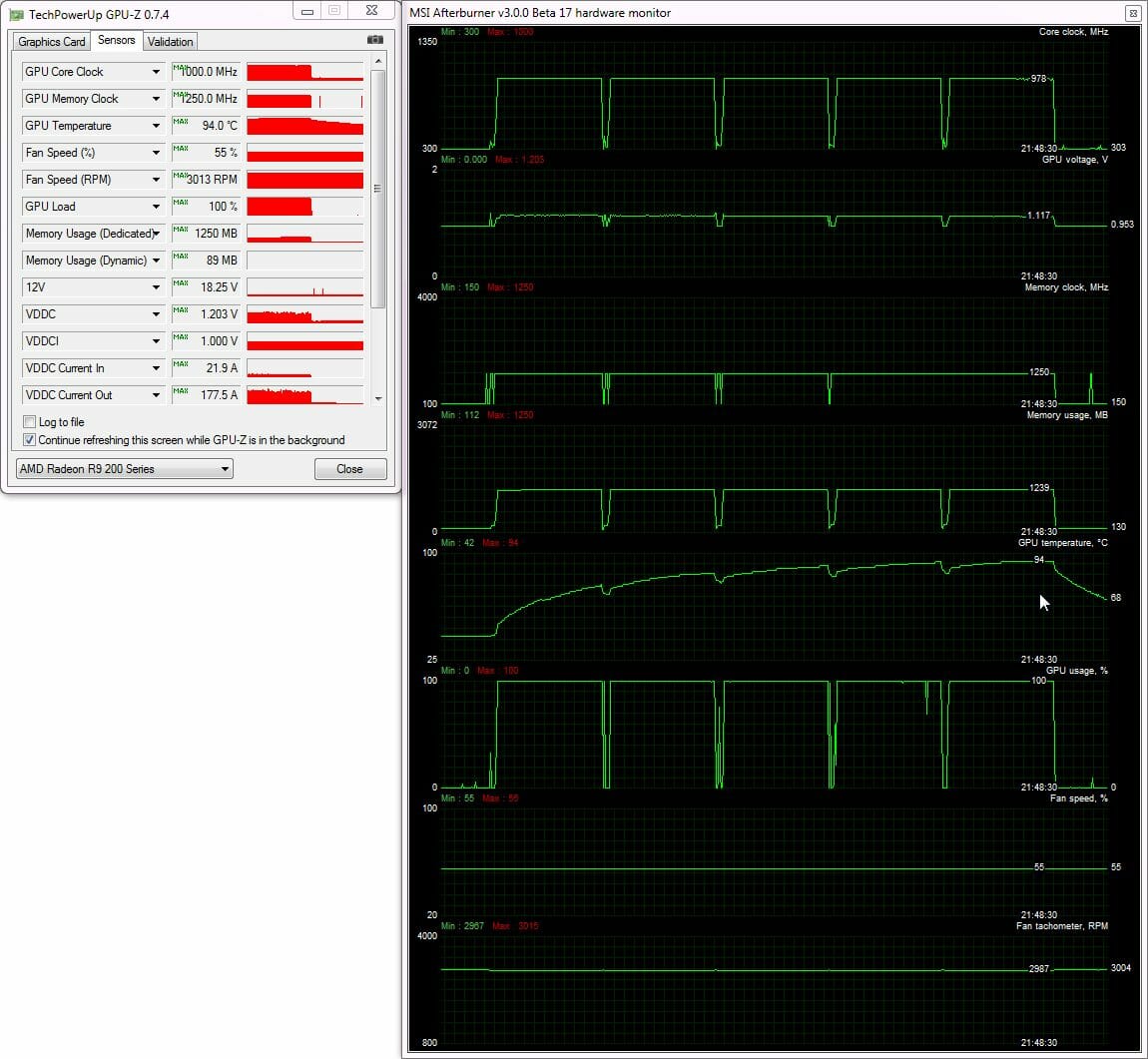
So we sped the fan up to 60% or 3340 RPM:
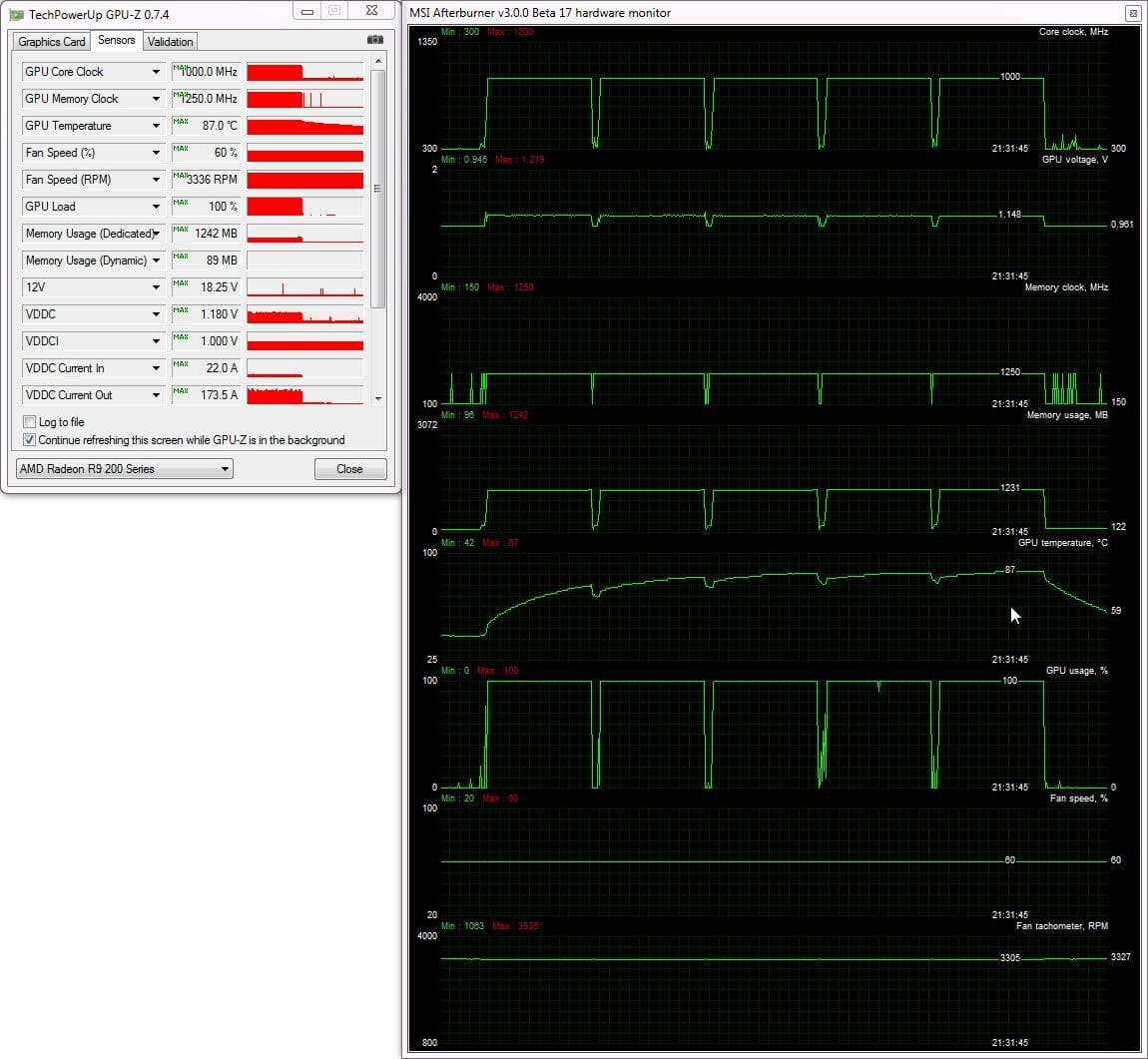
The GPU was no hotter than 87°C then and didn’t suffer any frequency drops. The card was too noisy at that speed of the fan, of course.
After we took the card apart and replaced its default thermal grease with Arctic MX-4, we carried out our temperature test one again and saw that there were no frequency drops at 55% fan speed.
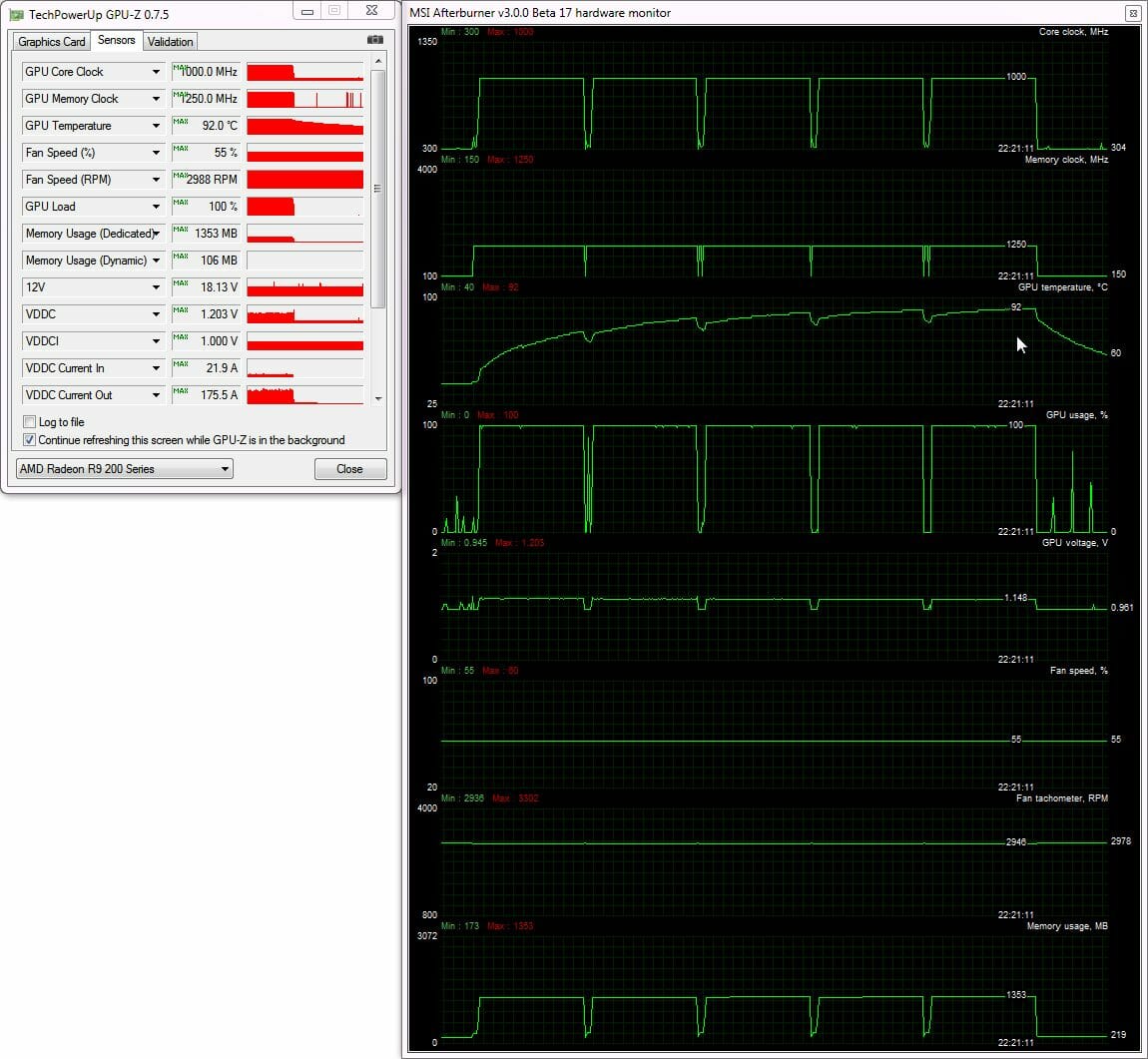
Replacing the default thermal interface seems to do the card some good. The peak temperature was close to the threshold, though. It is quite possible that the frequency would have dropped if the test had lasted longer.
We measured the level of noise using an electronic noise-level meter CENTER-321 in a closed and quiet room about 20 sq. meters large. The noise-level meter was set on a tripod at a distance of 15 centimeters from the graphics card which was installed on an open testbed. The mainboard with the graphics card was placed at an edge of a desk on a foam-rubber tray. The bottom limit of our noise-level meter is 29.8 dBA whereas the subjectively comfortable (not low, but comfortable) level of noise when measured from that distance is about 36 dBA. The speed of the graphics card’s fans was being adjusted by means of a controller that changed the supply voltage in steps of 0.5 V.
We’ve included the results of the reference Nvidia GeForce GTX 780 and two original cards, EVGA GeForce GTX 780 Superclocked ACX and MSI Radeon R9 280X Gaming, in the diagram below for the sake of comparison. We’ll also use these cards in our performance tests. The vertical dotted lines mark the top speed of the fans in the automatic regulation mode. There are two such lines for the AMD Radeon R9 290X: for the automatic Silent mode and for 55% fan speed.
Here are the results:
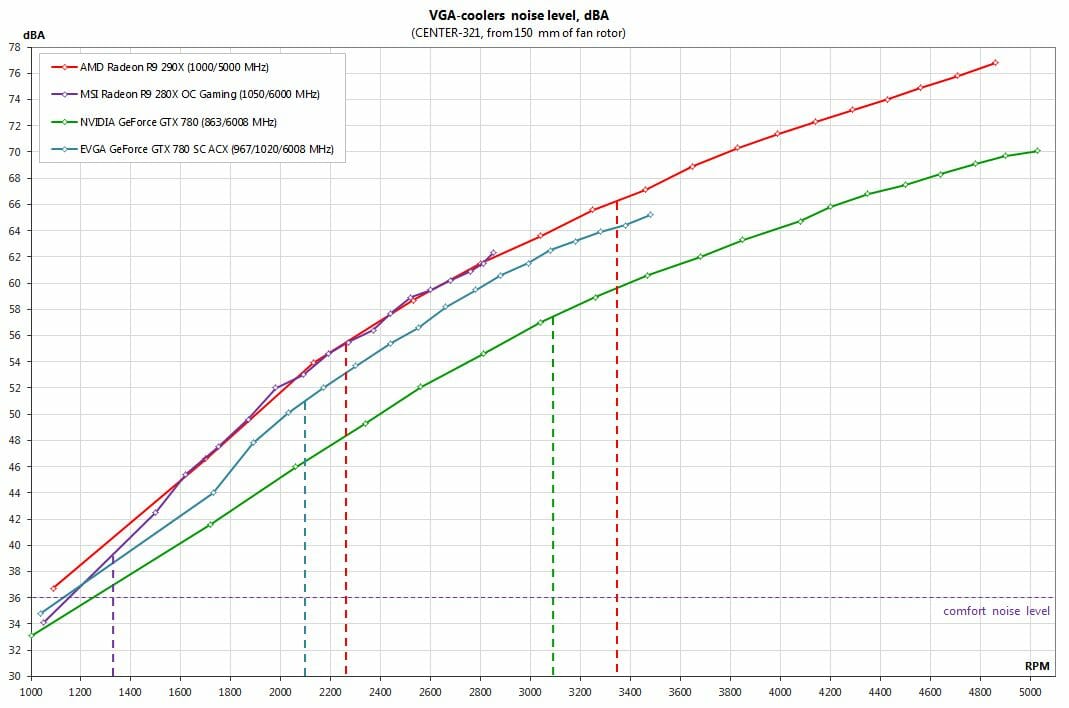
The Radeon R9 290X is the noisiest reference card. We had expected that even before the test, judging by our subjective impressions. The high heat dissipation of AMD’s new flagship means that its noise in the quiet mode is about as high as with the reference GeForce GTX 780 but the latter doesn’t drop its GPU frequency by 30%. When running 3D games at a stable 1000 MHz, the Radeon R9 290X has 55% fan speed, which is unbearably noisy. This graphics card is just not meant for home users.
Overclocking Potential
Our temperature tests make it clear that overclocking the reference Radeon R9 290X in the automatic fan regulation mode is pointless as the clock rate would just drop down as soon as the GPU temperature hit 94°C. That’s why we fixed the fan speed at 65% or 3660 RPM and didn’t increase the core voltage. We managed to increase the GPU and memory clock rates by 130 and 760 MHz, respectively.
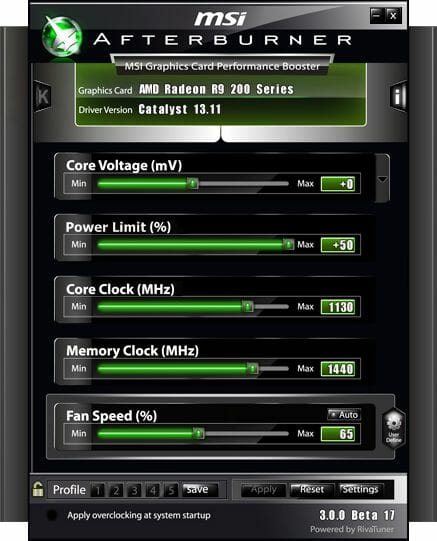
The resulting clock rates were 1130/5760 MHz:
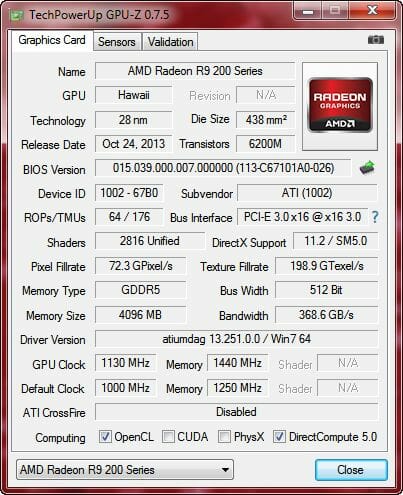
The fan worked at 65% of its full speed and roared mercilessly, yet the GPU was as hot as 90°C.
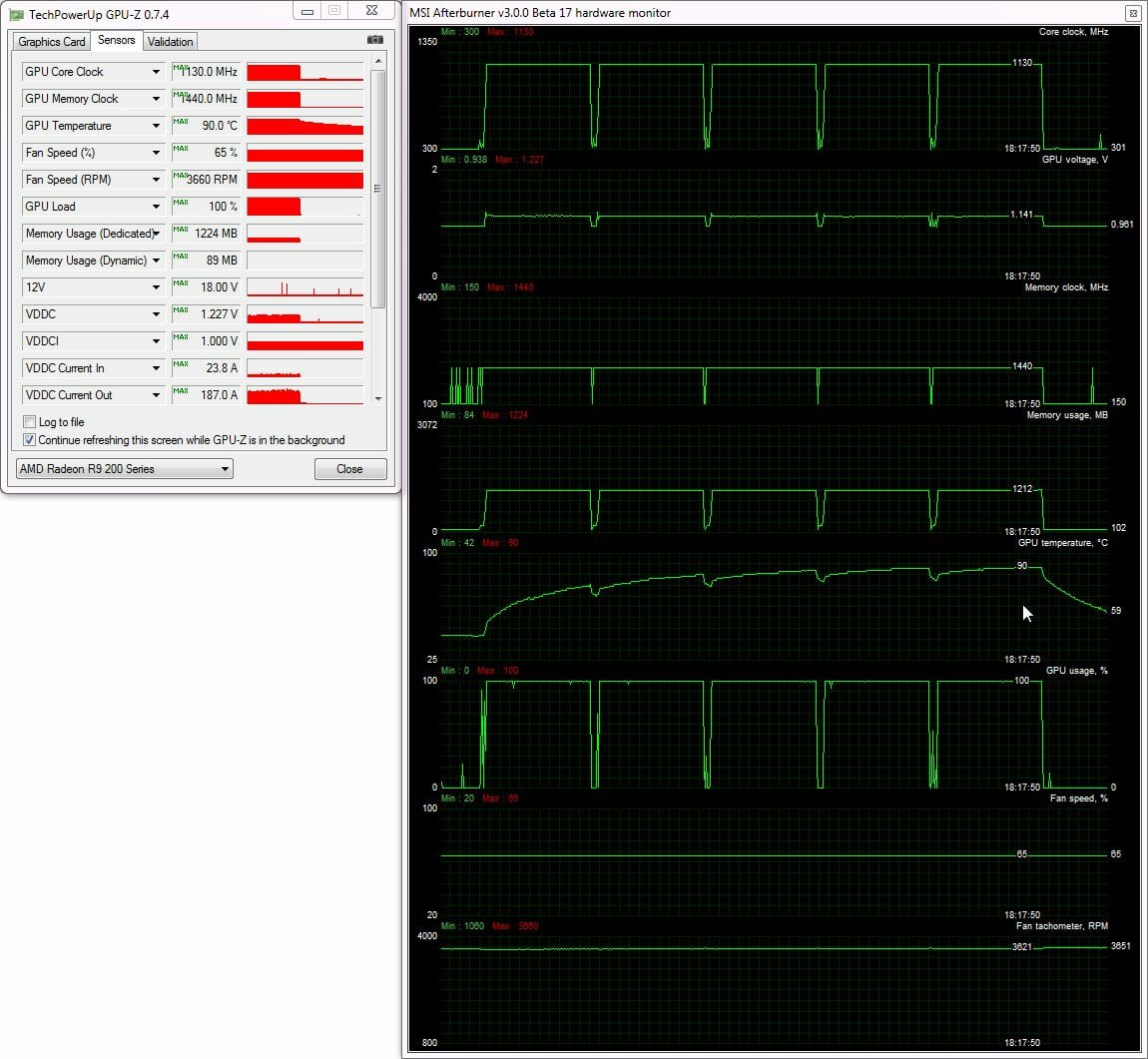
Even though we achieved some success in our overclocking experiment, we have to admit that the reference Radeon R9 290X is no good for overclocking unless you are completely deaf.
Testbed and Methods
Here is the list of components we use in our testbed.
- Mainboard: Intel Siler DX79SR (Intel X79 Express, LGA 2011, BIOS 0590 dated 17.07.2013)
- CPU: Intel Core i7-3970X Extreme Edition 3.5/4.0 GHz (Sandy Bridge-E, C2, 1.1 V, 6x256KB L2 cache, 15MB L3 cache)
- CPU cooler: Phanteks PH-TC14PЕ (2x Corsair AF140 fans, 900 RPM)
- Thermal grease: ARCTIC MX-4
- Graphics cards:
- Nvidia GeForce GTX 780 Ti 3GB (876/928/7000 MHz)
- EVGA GeForce GTX 780 Superclocked ACX 3GB (863/916/6008 MHz; and overclocked to 1032/1085/7348 MHz)
- AMD Radeon R9 290X 4GB (1000/5000 MHz and overclocked to 1130/5760 MHz)
- MSI Radeon R9 280X Gaming 3GB (1050/6000 MHz)
- System memory: DDR3 4x8GB G.SKILL TridentX F3-2133C9Q-32GTX (2133 MHz, 9-11-11-31, 1.6 V)
- System disk: SSD 256GB Crucial m4 (SATA 6 Gbit/s, CT256M4SSD2, BIOS v0009)
- Games/software disk: Western Digital VelociRaptor (SATA-2, 300 GB, 10000 RPM, 16 MB cache, NCQ) in a Scythe Quiet Drive 3.5″ enclosure
- Backup disk: Samsung Ecogreen F4 HD204UI (SATA-2, 2 TB, 5400 RPM, 32 MB cache, NCQ)
- Computer case: Antec Twelve Hundred (front panel: three Noiseblocker NB-Multiframe S-Series MF12-S2 fans at 1020 RPM; back panel: two Noiseblocker NB-BlackSilentPRO PL-1 fans at 1020 RPM; top panel: one preinstalled 200mm fan at 400 RPM)
- Control & monitoring panel: Zalman ZM-MFC3
- Power supply: Corsair AX1200i (1200 W), 120mm fan
- Monitor: 27″ Samsung S27A850D (DVI-I, 2560×1440, 60 Hz)
As we are going to check out the performance growth within AMD’s own model range, we will compare the Radeon R9 290X with a Radeon R9 280X (previously known as Radeon HD 7970 GHz Edition) in its version from MSI.
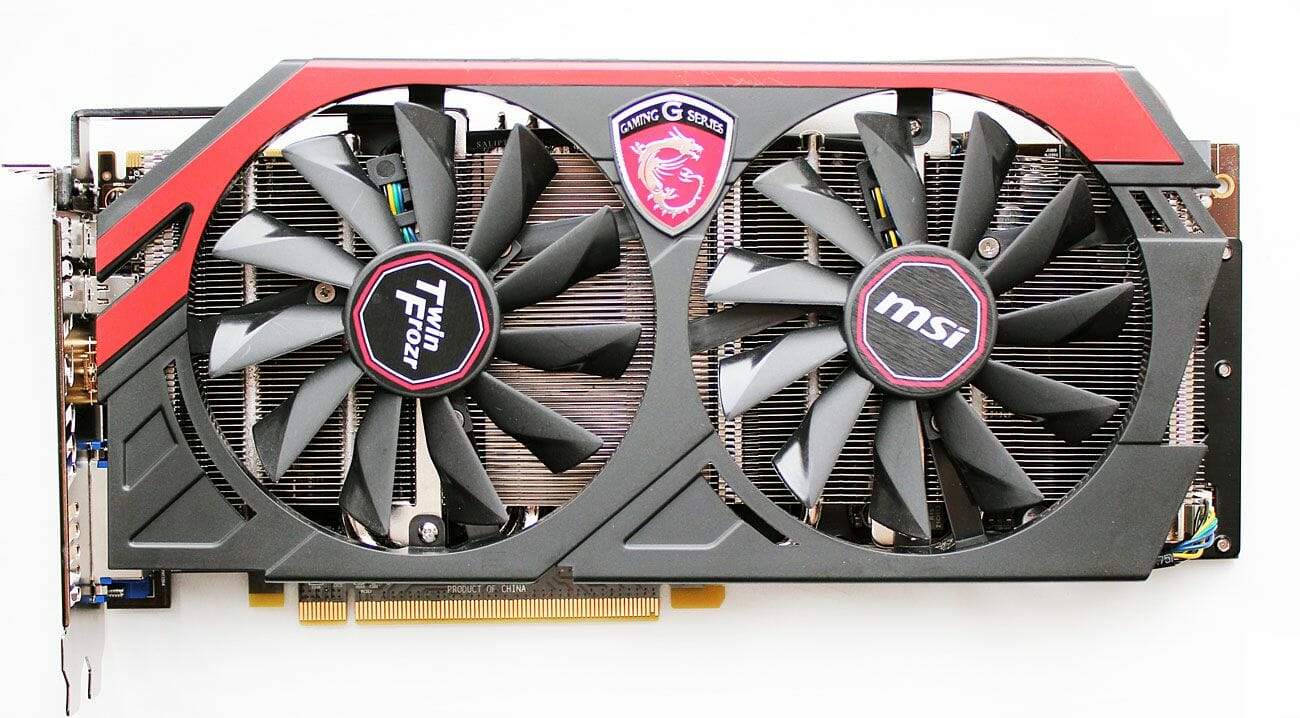
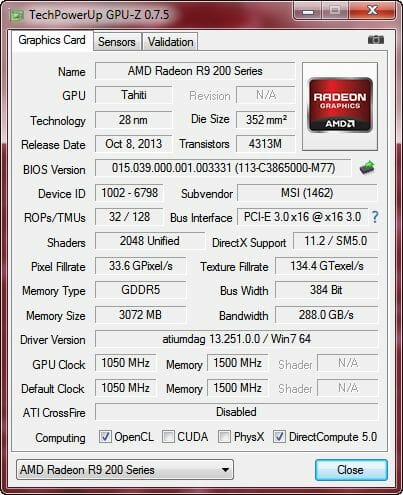
The MSI card’s GPU is pre-overclocked by 50 MHz, but we guess this is a negligible thing for such top-end graphics solutions.
The second opponent we’ve chosen for our Radeon R9 290X is, of course, a GeForce GTX 780. We don’t have any reference versions of that card left, so we take an EVGA GeForce GTX 780 Superclocked ACX 3GB and run it in two modes: at the clock rates of the reference GTX 780 and at the highest clock rates supported by our sample of the EVGA card.
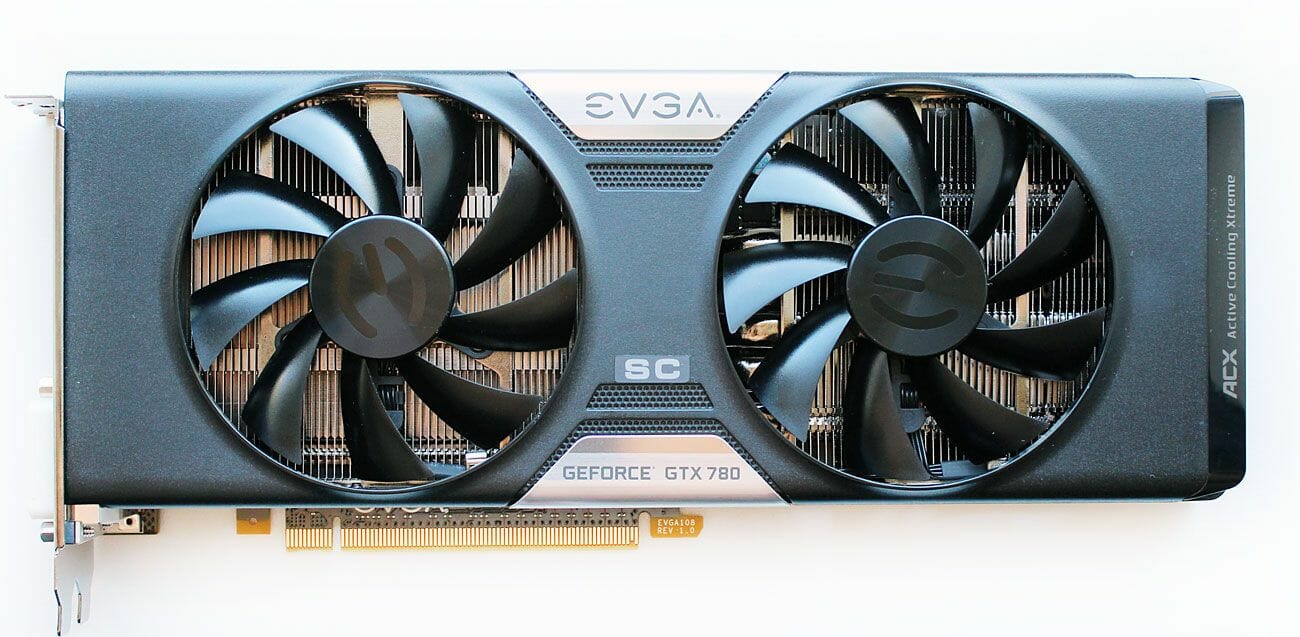
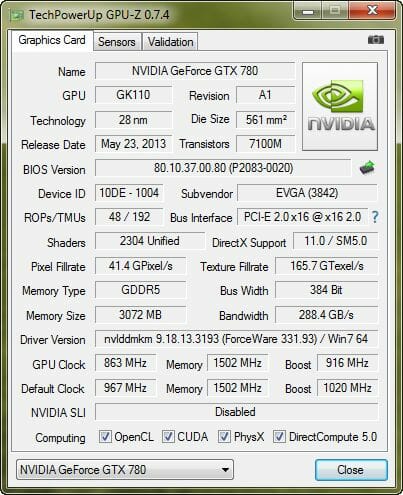
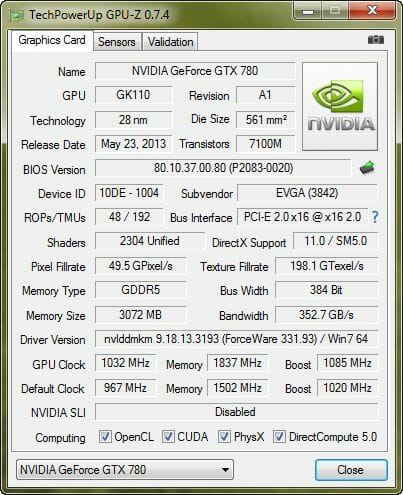
We will also compare the Radeon R9 290X with a GeForce GTX 780 Ti which is currently somewhat more expensive, yet can be viewed as the Radeon’s market opponent. We will use a reference GTX 780 Ti with default clock rates:
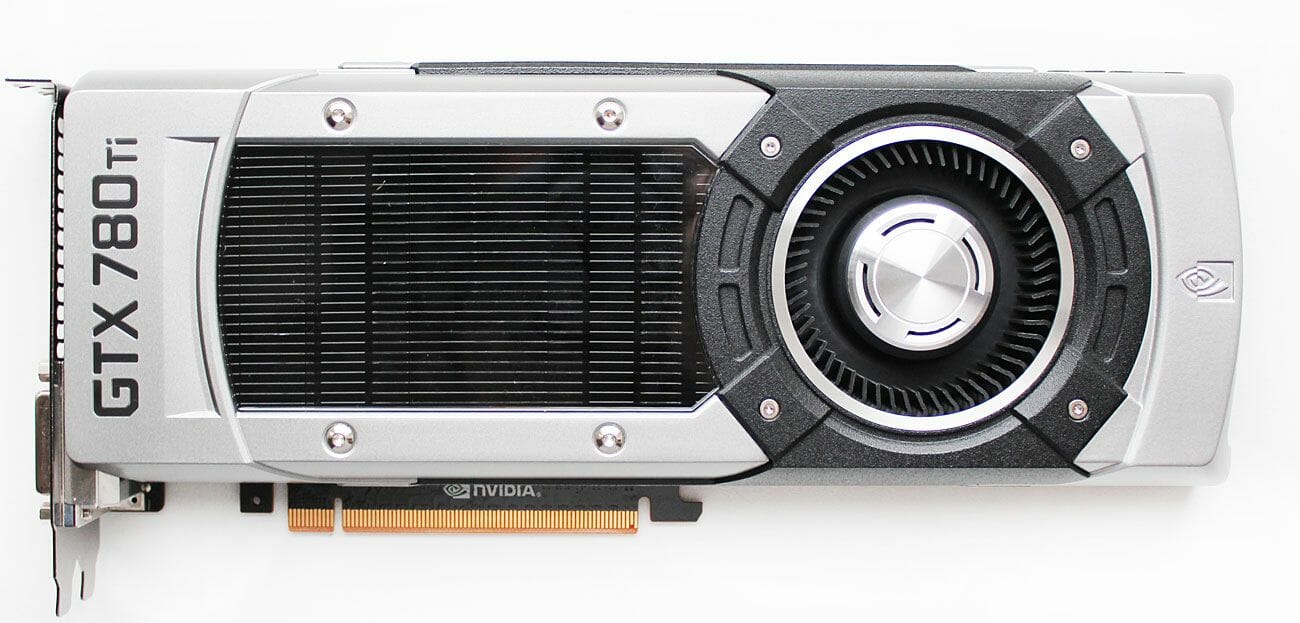
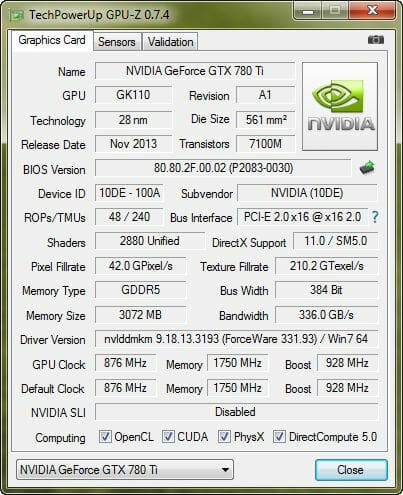
In order to lower the dependence of the graphics cards’ performance on the overall platform speed, we overclocked our 32nm six-core CPU to 4.8 GHz by setting its frequency multiplier at x48 and enabling Loadline Calibration. The CPU’s voltage was increased to 1.38 volts in the mainboard’s BIOS:
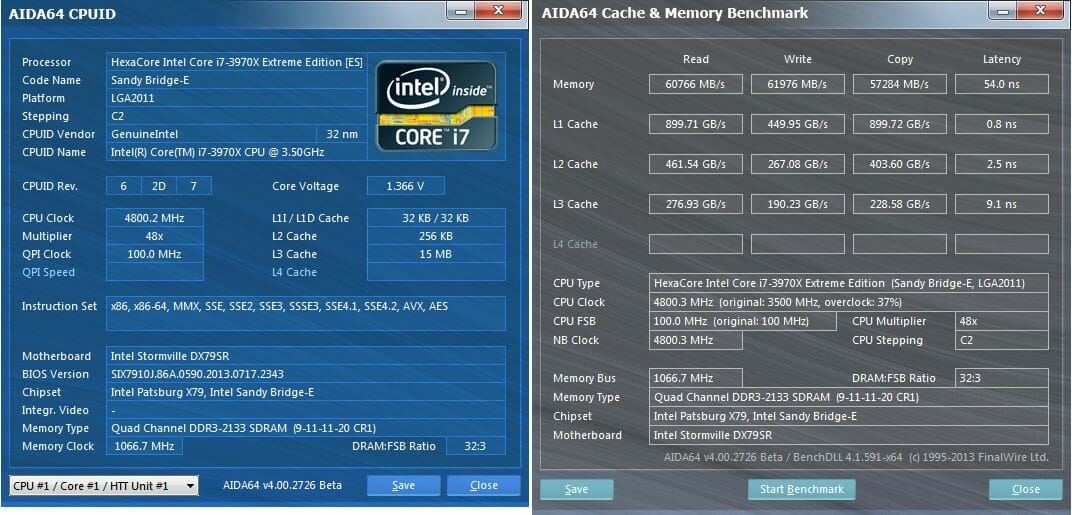
Hyper-Threading was turned on. We used 32 GB of system memory at 2.133 GHz with timings of 9-11-11-20_CR1 and voltage of 1.6125 volts.
The testbed ran Microsoft Windows 7 Ultimate x64 SP1 with all critical updates installed. We used the following drivers:
- Intel Chipset Drivers – 9.4.4.1006 WHQL dated 21.09.2013
- DirectX End-User Runtimes, dated 30 November 2010
- AMD Catalyst 13.12 WHQL (13.251.0.0) dated 18.12.2013
- GeForce 331.93 Beta dated 27.11.2013
We benchmarked the graphics cards’ performance at two display resolutions: 1920×1080 and 2560×1440 pixels. There were two visual quality modes: “Quality+AF16x” means the default texturing quality in the drivers + 16x anisotropic filtering whereas “Quality+ AF16x+MSAA 4x(8x)” means 16x anisotropic filtering and 4x or 8x antialiasing. We enabled anisotropic filtering and full-screen antialiasing from the game’s menu. If the corresponding options were missing, we changed these settings in the Control Panels of the Catalyst and GeForce drivers. We also disabled Vsync there. There were no other changes in the driver settings.
The graphics cards were tested in two benchmarks and 15 games updated to the latest versions. Batman: Arkham Origins returns to our test programs whereas Battlefield 4 debuts in it:
- 3DMark (2013) (DirectX 9/11) – version 1.2.250.0; Cloud Gate, Fire Strike and Fire Strike Extreme scenes.
- Unigine Valley Bench (DirectX 11) – version 1.0, maximum visual quality settings, 16x AF and/or 4x MSAA, 1920х1080.
- Total War: SHOGUN 2 – Fall of the Samurai (DirectX 11) – version 1.1.0, integrated benchmark (the Sekigahara battle) with the maximum visual quality settings and 8x MSAA.
- Battlefield 3 (DirectX 11) – version 1.4, Ultra settings, two successive runs of a scripted scene from the beginning of the “Going Hunting” mission (110 seconds long).
- Sniper Elite V2 Benchmark (DirectX 11) – version 1.05, we used Adrenaline Sniper Elite V2 Benchmark Tool v1.0.0.2 BETA with maximum graphics quality settings (“Ultra” profile), Advanced Shadows: HIGH, Ambient Occlusion: ON, Stereo 3D: OFF, Supersampling: OFF, two sequential runs of the test.
- Sleeping Dogs (DirectX 11) – version 1.5, we used Adrenaline Sleeping Dogs Benchmark Tool v1.0.2.1 with maximum image quality settings, Hi-Res Textures pack installed, FPS Limiter and V-Sync disabled, two consecutive runs of the built-in benchmark with quality antialiasing at Normal and Extreme levels.
- Hitman: Absolution (DirectX 11) – version 1.0.447.0, built-in test with Ultra settings, enabled tessellation, FXAA and global lighting.
- Crysis 3 (DirectX 11) – version 1.2.0.1000, maximum visual quality settings, Motion Blur – Medium, lens flares – on, FXAA and MSAA 4x, two consecutive runs of a scripted scene from the beginning of the “Swamp” mission (110 seconds long).
- Tomb Raider (2013) (DirectX 11) – version 1.1.748.0, we used Adrenaline Benchmark Tool, all image quality settings set to “Ultra”, V-Sync disabled, FXAA and 2x SSAA antialiasing enabled, TessFX technology activated, two consecutive runs of the in-game benchmark.
- BioShock Infinite (DirectX 11) – version 1.1.24.21018, we used Adrenaline Action Benchmark Tool with “Ultra” and “Ultra+DOF” quality settings, two consecutive runs of the in-game benchmark.
- Metro: Last Light (DirectX 11) – version 1.0.0.15, we used the built-in benchmark for two consecutive runs of the D6 scene. All image quality and tessellation settings were at “Very High”, Advanced PhysX technology was enabled, we tested with and without SSAA antialiasing.
- GRID 2 (DirectX 11) – version 1.0.85.8679, we used the built-in benchmark, the visual quality settings were all at their maximums, the tests were run with and without MSAA 8x antialiasing with eight cars on the Chicago track.
- Company of Heroes 2 (DirectX 11) – version 3.0.0.11811, two consecutive runs of the integrated benchmark at maximum image quality and physics effects settings.
- Total War: Rome II (DirectX 11) — version 1.8.0 build 8891.481024, Extreme quality, V-Sync disabled, SSAA enabled, two consecutive runs of the integrated benchmark.
- ArmA III (DirectX 11) — version 1.08.0.113494, we used the ArmA3Mark benchmark with the Ultra quality, V-Sync disabled, two consecutive runs of the integrated benchmark.
- Batman: Arkham Origins (DirectX 11) – version 1.0 update 8, Ultra visual quality, V-Sync disabled, all the effects enabled, all DX11 Enhanced features enabled, Hardware Accelerated PhysX = Normal, two consecutive runs of the in-game benchmarks.
- Battlefield 4 (DirectX 11) – version 1.4, Ultra settings, two successive runs of a scripted scene from the beginning of the “Tashgar” mission (110 seconds long).
We publish the bottom frame rate for games that report it. Each test was run twice, the final result being the best of the two if they differed by less than 1%. If we had a larger difference, we reran the test at least once to get repeatable results.
Performance
The results of the AMD Radeon R9 290X at its default and overclocked frequencies are indicated in red. The color of the Nvidia GeForce GTX 780 Ti is green. The EVGA GeForce GTX 780 Superclocked ACX is turquoise and the MSI Radeon R9 280X Gaming is lilac.
3DMark 2013
AMD-based cards have always been strong in Futuremark’s tests, so it is no wonder that the Radeon R9 290X feels at its ease in the newest 3DMark:
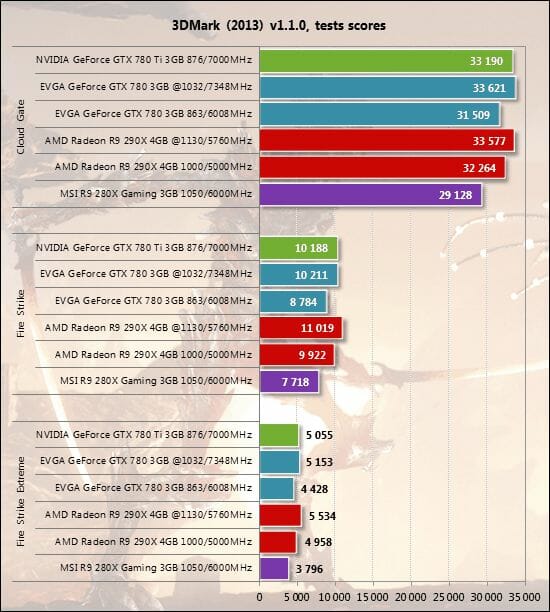
At the default clock rates the Radeon R9 290X is up to 31% faster than the MSI Radeon R9 280X Gaming and is also ahead of the GeForce GTX 780. When overclocked, it can challenge the slightly more expensive GeForce GTX 780 Ti. Of course, the latter can be easily overclocked as well, yet the first results of the Radeon R9 290X look encouraging.
Unigine Valley Bench
This benchmark shows us a different picture:
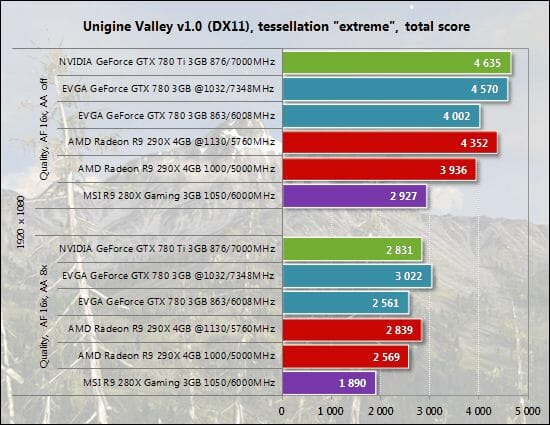
The Radeon R9 290X still enjoys a hefty advantage over the MSI Radeon R9 280X Gaming – 34 to 36%, yet this is barely enough to compete with the more affordable GeForce GTX 780. When both cards are overclocked, the GTX 780 is superior.
Now let’s turn to our gaming tests.
Total War: SHOGUN 2 – Fall of the Samurai
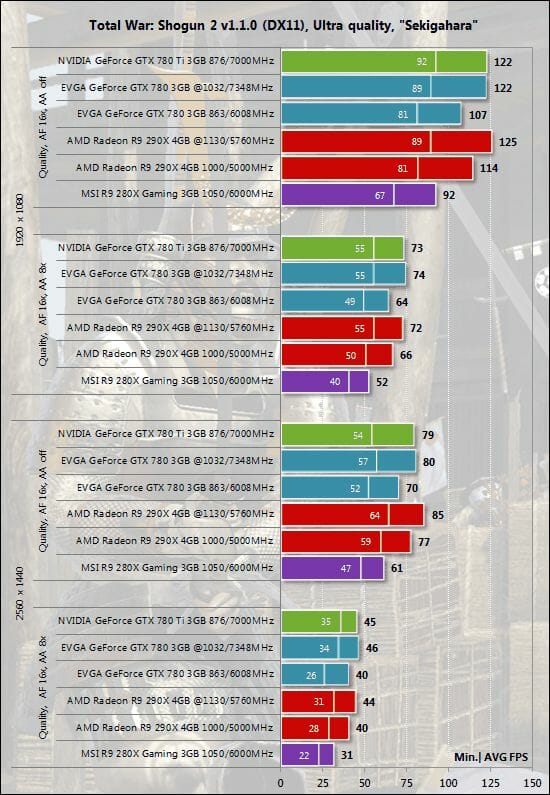
Excepting the most resource-consuming settings (2560×1440 with 8x antialiasing), the Radeon R9 290X proves to be a little faster than the GeForce GTX 780, both working at their standard clock rates. But thanks to the higher frequency potential of the EVGA card, the overclocked GTX 780 is just as good as the overclocked R9 290X. Original Radeon R9 290X cards will probably overclock much better, yet Nvidia has the advantage of time and also an ace in its sleeve in the way of the GeForce GTX 780 Ti.
Note also that the Radeon R9 290X is 24 to 29% ahead of the MSI Radeon R9 280X Gaming here.
Battlefield 3
The standings are overall the same as in the previous game:
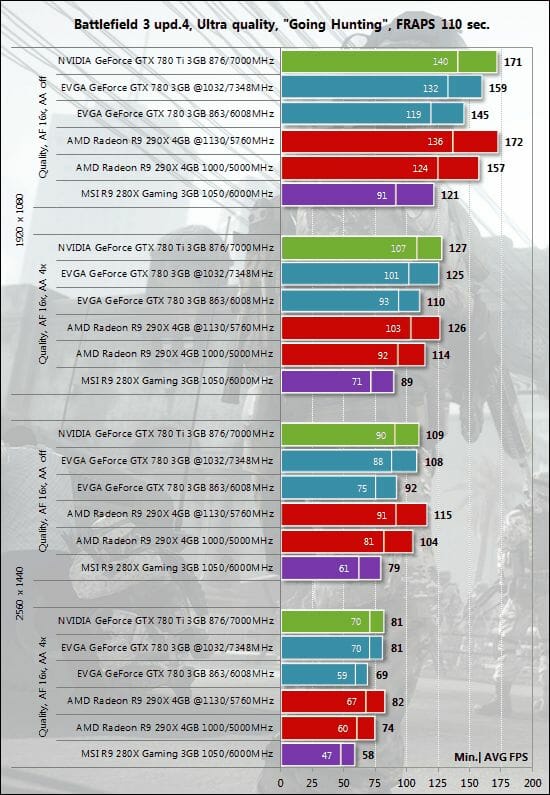
We can just note that the Radeon R9 290X enjoys a larger advantage over the MSI Radeon R9 280X Gaming: 28 to 32%.
Sniper Elite V2 Benchmark
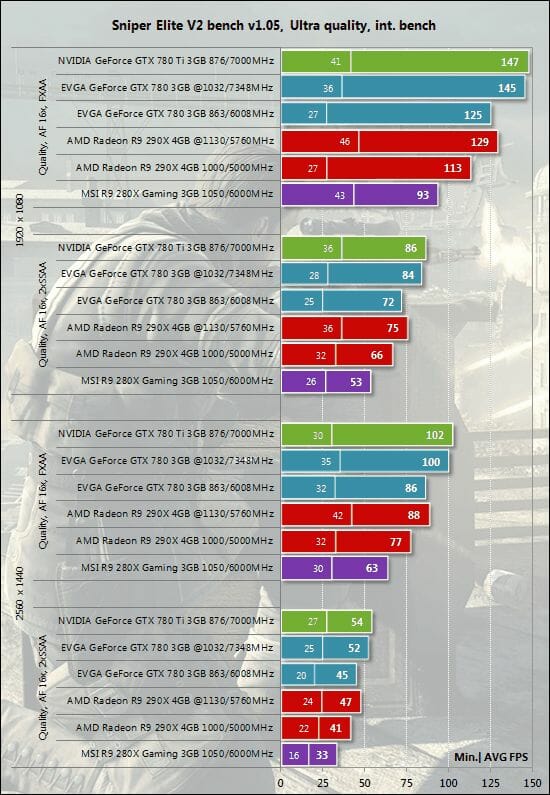
As opposed to the two previous tests, it is the Nvidia-based cards that are ahead here.
The Radeon R9 290X is 8 to 11% behind the GeForce GTX 780 at the standard clock rates and only manages to bridge the gap by means of overclocking. The new card from AMD can’t compete with the GeForce GTX 780 Ti in this game and outperforms the MSI Radeon R9 280X Gaming by 22 to 25%. That doesn’t seem to be as large an advantage as we expected from the specs of the new Hawaii XT GPU.
Sleeping Dogs
The AMD Radeon R9 290X is unrivaled in this game:
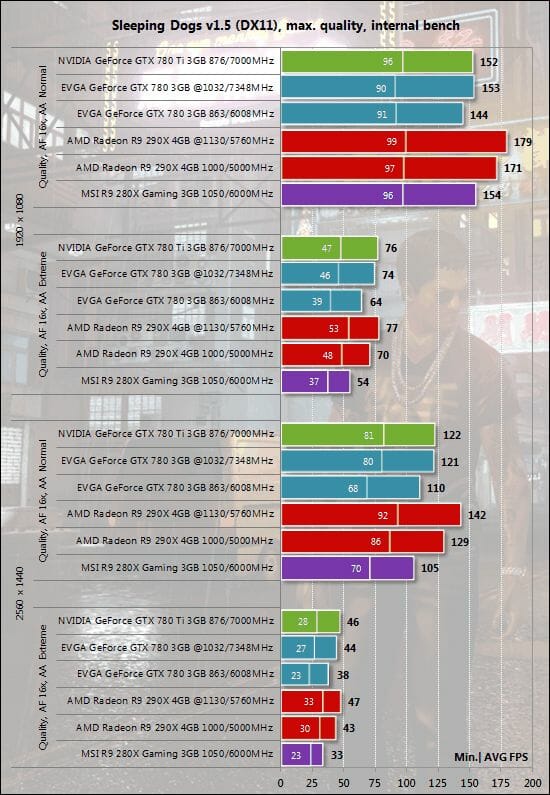
It is only at 2560×1440 with antialiasing that the GeForce GTX 780 and the GeForce GTX 780 Ti can fight back.
Hitman: Absolution
This game is yet another example of an application where AMD-based cards are traditionally stronger than their Nvidia-based opponents.
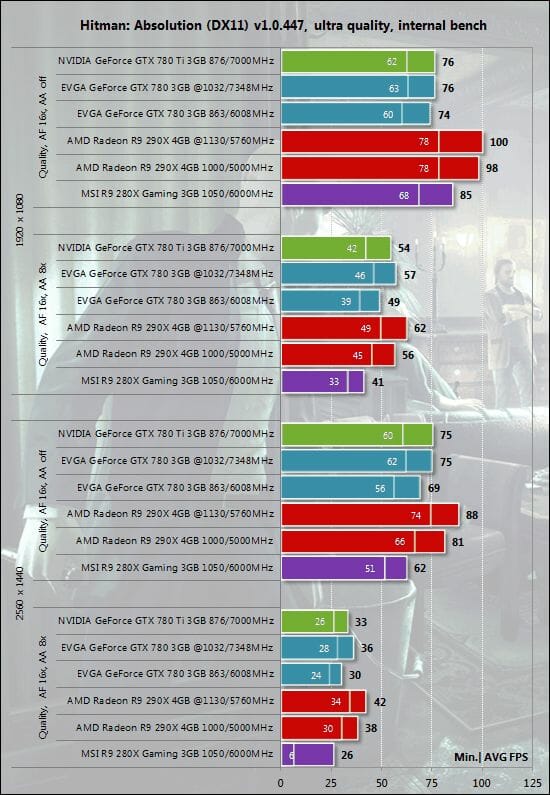
The Radeon R9 290X is 14 to 32% faster than the GeForce GTX 780. Its advantage over its predecessor Radeon R9 280X (or Radeon HD 7970 GHz Edition) amounts up to 46%.
Crysis 3
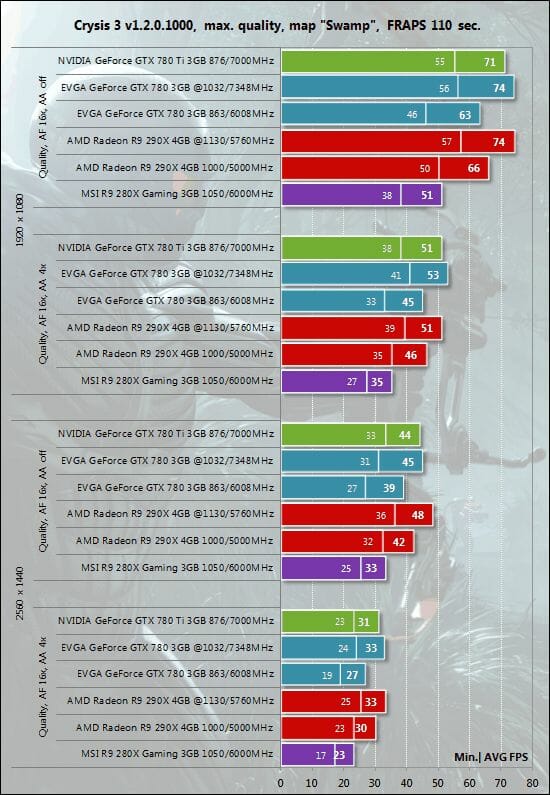
The Radeon R9 290X is always a little faster than the GeForce GTX 780 when both work at their default clock rates. When overclocked, they are roughly equal to each other and ahead of the GeForce GTX 780 Ti. The MSI Radeon R9 280X Gaming is a typical 29 to 31% behind the new AMD solution.
Tomb Raider (2013)
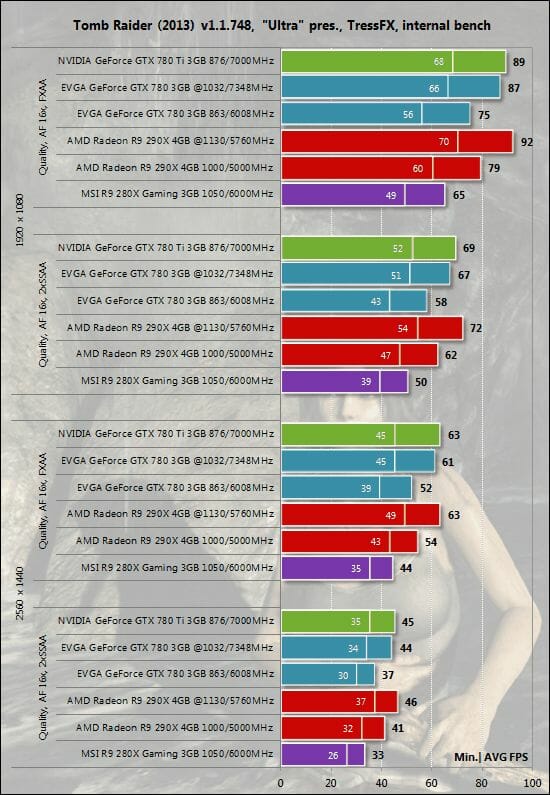
The gap between the Radeon R9 290X and the MSI Radeon R9 280X Gaming is smaller than average in this game: 22 to 24%.
The Radeon R9 290X is 5 to 11% ahead of the GeForce GTX 780 in every test mode. When overclocked, it even beats the standard GeForce GTX 780 Ti!
BioShock Infinite
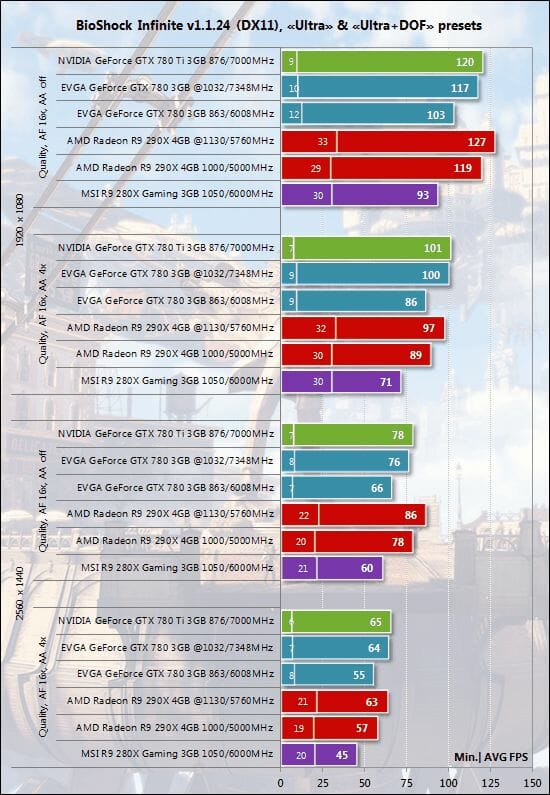
This game’s rendering engine is favorable towards AMD GPUs, therefore the Radeon R9 290X is always better than the GeForce GTX 780. It must be noted that the new card from AMD isn’t far ahead when we enable antialiasing, but each of the AMD-based solutions can deliver higher bottom speed, which is important for smooth gameplay.
Metro: Last Light
First, let’s check this game out with the Advanced PhysX option turned on:
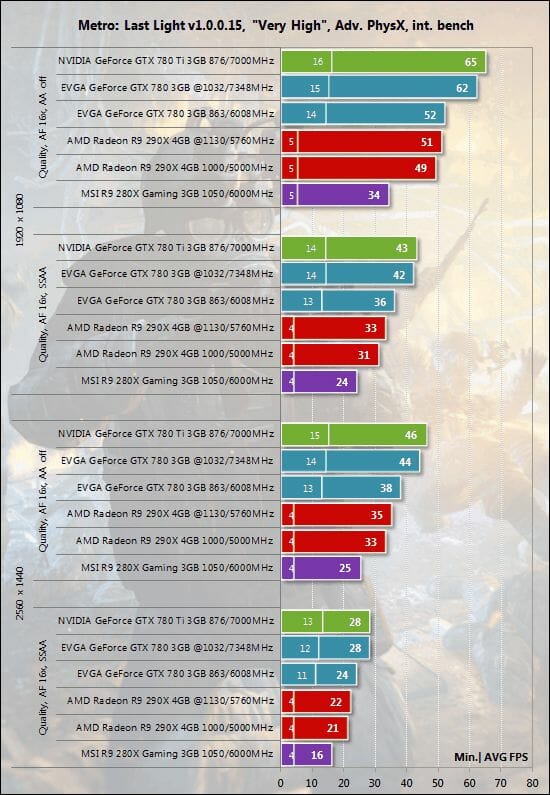
The GeForce series are unrivaled in this case. The Radeon R9 290X is left to compete against the MSI Radeon R9 280X Gaming, beating it by 29 to 44%.
It’s different when we disable Advanced PhysX:
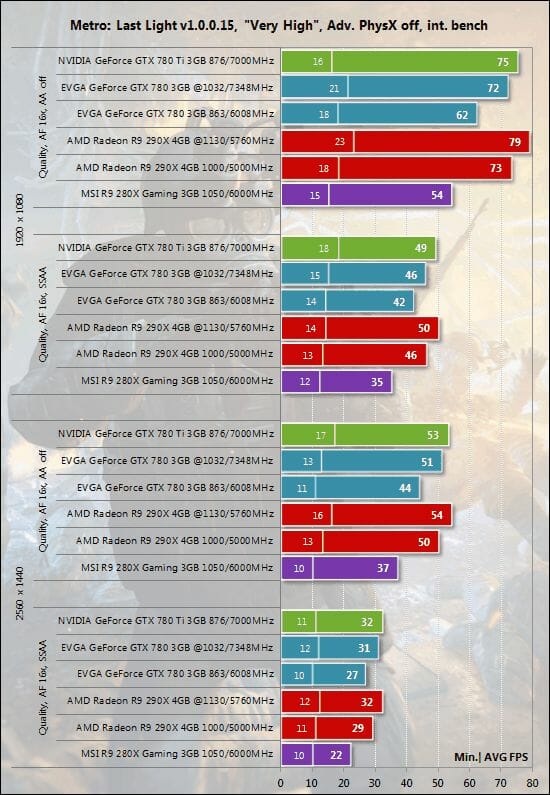
The Radeon R9 290X is superior in every test mode, enjoying a large advantage over the GeForce GTX 780 when SSAA is turned off. When overclocked, it even beats the standard GeForce GTX 780 Ti.
GRID 2
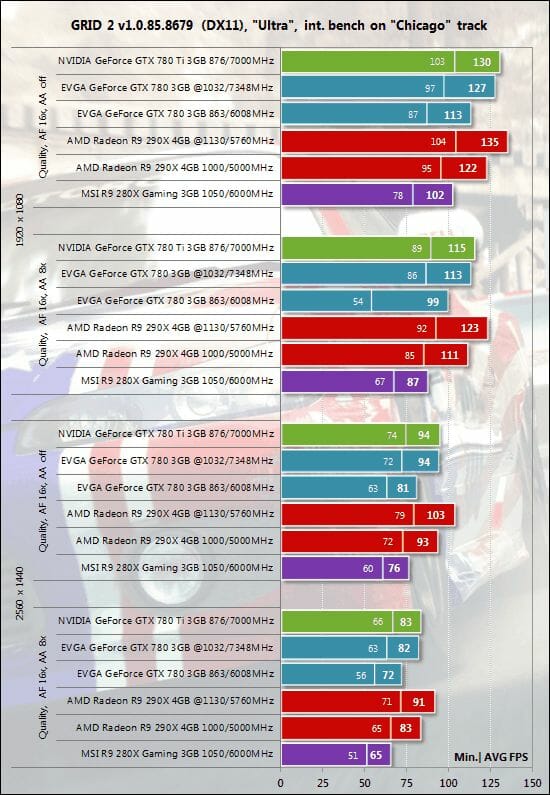
GRID 2 runs faster on the AMD-based solutions. The Radeon R9 290X is 8 to 15% ahead of the GeForce GTX 780 and gets very close to the GTX 780 Ti in some of the test modes. Its advantage over the MSI Radeon R9 280X Gaming amounts to 20-28%.
Company of Heroes 2
The Radeon R9 290X is even more impressive in this game:
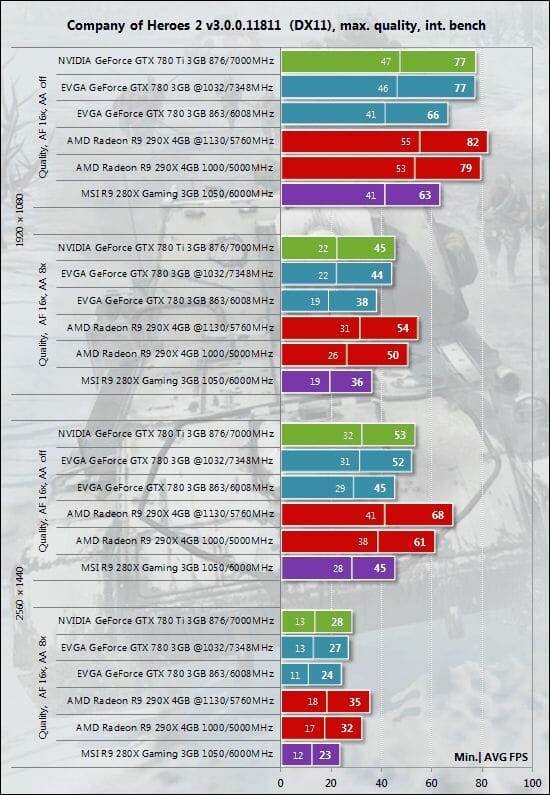
It beats the GeForce GTX 780 by 20-36% and leaves the GTX 780 Ti behind, too. Its Tahiti XT-based predecessor is slower by 25 to 39%.
Total War: Rome II
Here is yet another game where the Radeon R9 290X beats the GeForce GTX 780:
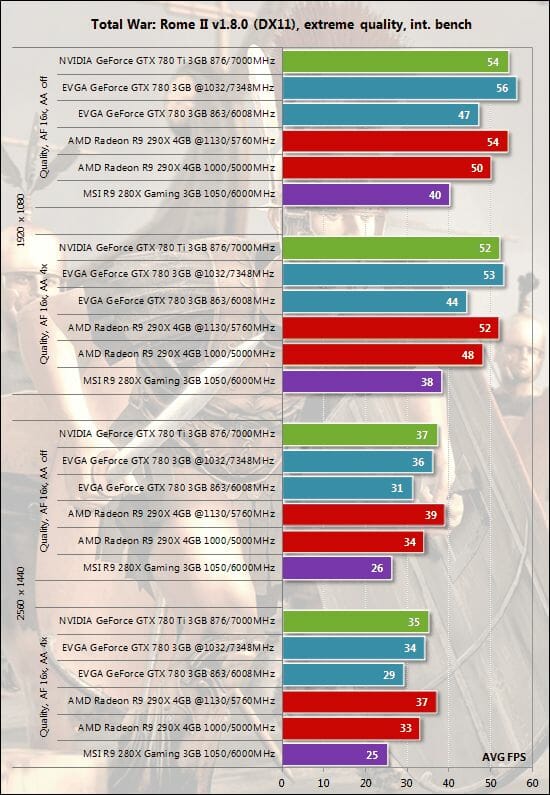
The gap isn’t large, yet AMD is superior. The overclocked Radeon R9 290X is comparable to the standard GeForce GTX 780 Ti again.
ArmA III
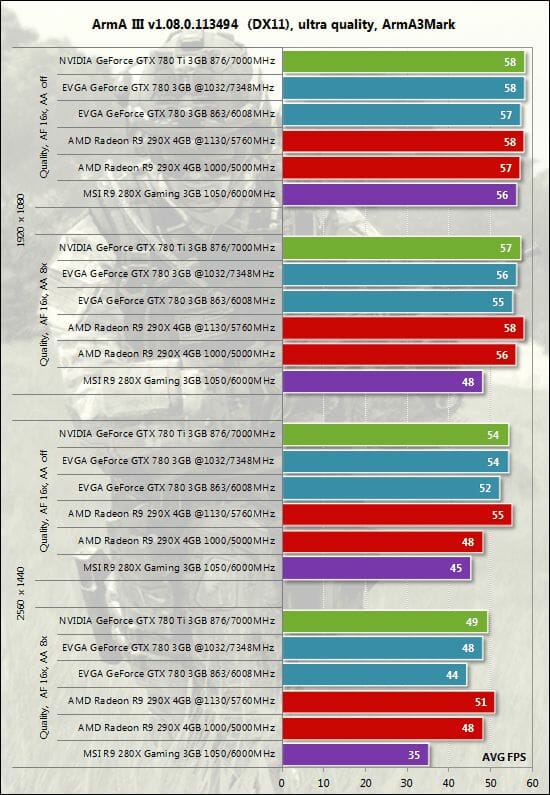
Top-end graphics cards can only be compared at the most resource-consuming settings in this benchmark. Otherwise, their speed is limited by the overall performance of the platform.
Batman: Arkham Origins
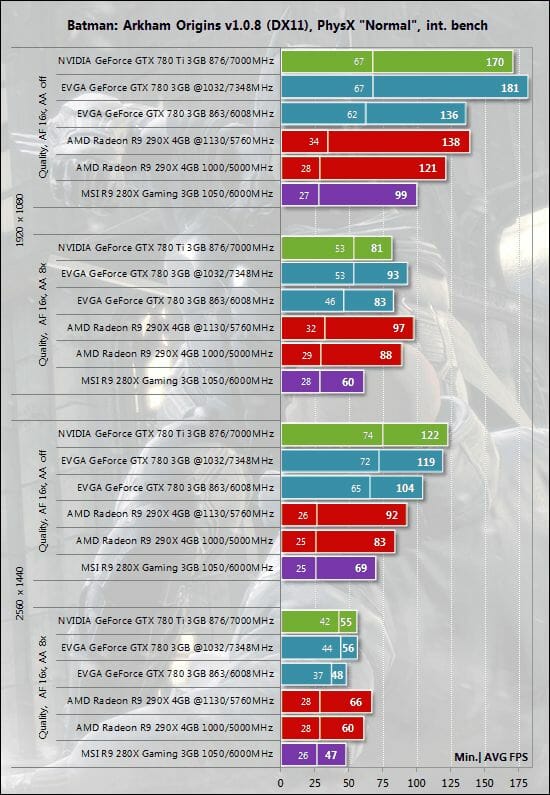
Returning to our testing program after a recent update, the game suggests that the Radeon R9 290X is overall slower than the GeForce GTX 780.
However, we can note that the Radeon R9 290X is just as good as the GeForce GTX 780 when we enable antialiasing. And most gamers are likely to enable it on such top-end graphics cards. The Radeon R9 290X even beats its opponent and the GeForce GTX 780 Ti in the heaviest test mode. It is in this game that we observe the largest gap between the Radeon R9 290X and the Radeon R9 280X. It is as large as 47%!
Battlefield 4
It’s the first time we ever use Battlefield 4 for our benchmarking, so we want to show you the graphics settings we use (we vary the resolution and the antialiasing mode, of course):
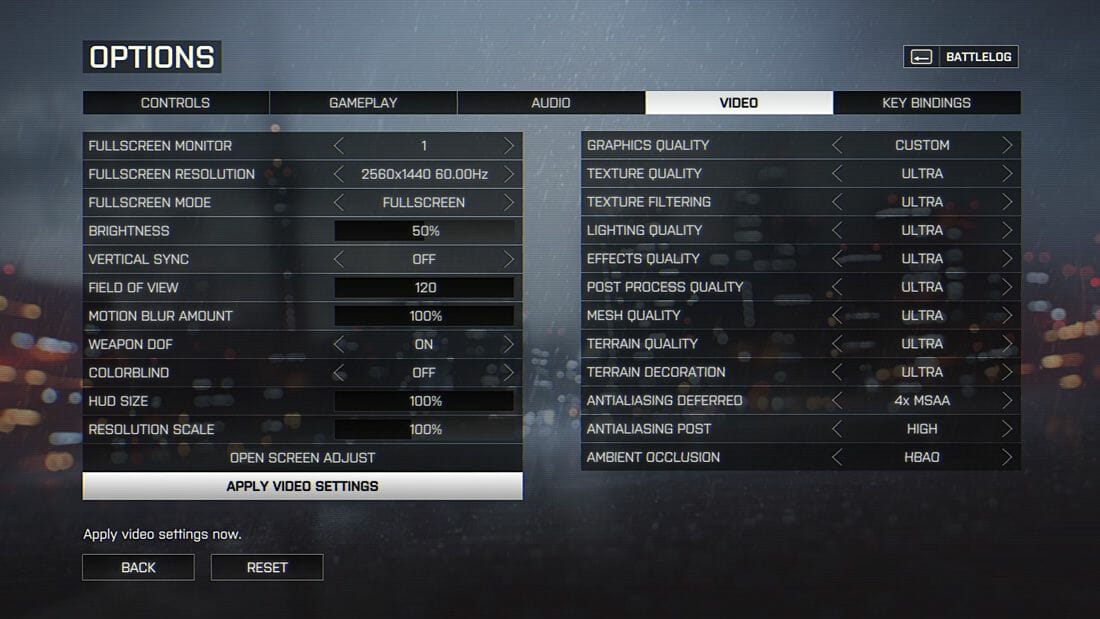
As you can see, we choose the maximum visual quality possible. But you should lower the numbers by 20-25% to estimate the real-life frame rate because the intro scene is not actual gameplay with its numerous explosions and shootouts.
Here are the results:
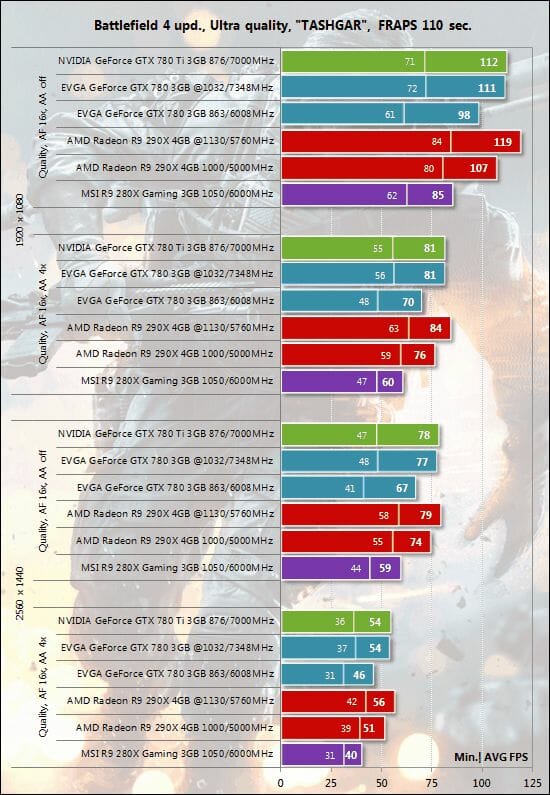
The Radeon R9 290X beats the GeForce GTX 780 once again. The new Radeon is fast indeed and can outperform the standard GeForce GTX 780 Ti when overclocked. Its advantage over the Radeon R9 280X amounts to 26-28% here.
Now we can proceed to our performance summary charts.
Performance Summary Charts
First of all, let’s see how faster the new single-GPU flagship Radeon R9 290X in comparison with its predecessor (Radeon HD 7970 GHz Edition) as represented by the MSI Radeon R9 280X Gaming. The latter serves as the baseline:
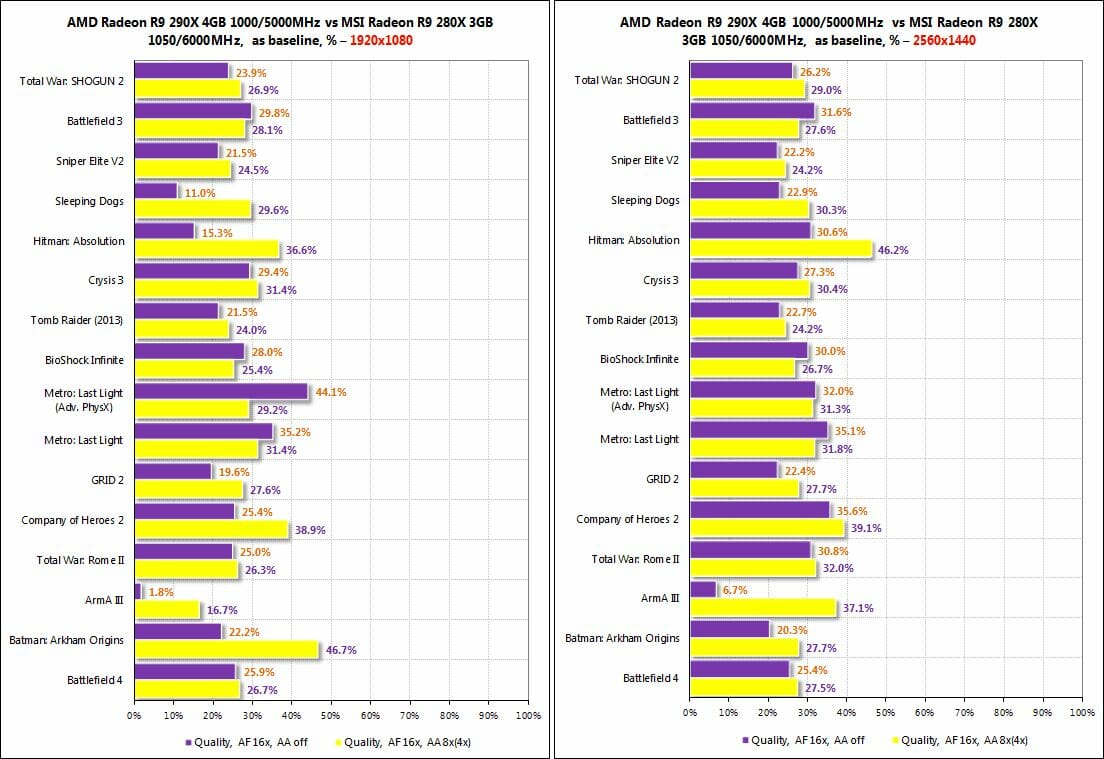
The average performance growth is 23-26% without antialiasing and 29-31% with antialiasing across all the tests. We can recall the GeForce GTX Titan which was 34-55% faster than the GeForce GTX 680 at the time of its release, but the Titan costs $1000 even now. Moreover, the Gaming card from MSI is pre-overclocked by 50 MHz, which adds 2-3% to the performance of the reference Radeon R9 280X.
The second pair of our summary charts helps compare the Radeon R9 290X and the GeForce GTX 780 at their default clock rates, the latter card serving as the baseline.
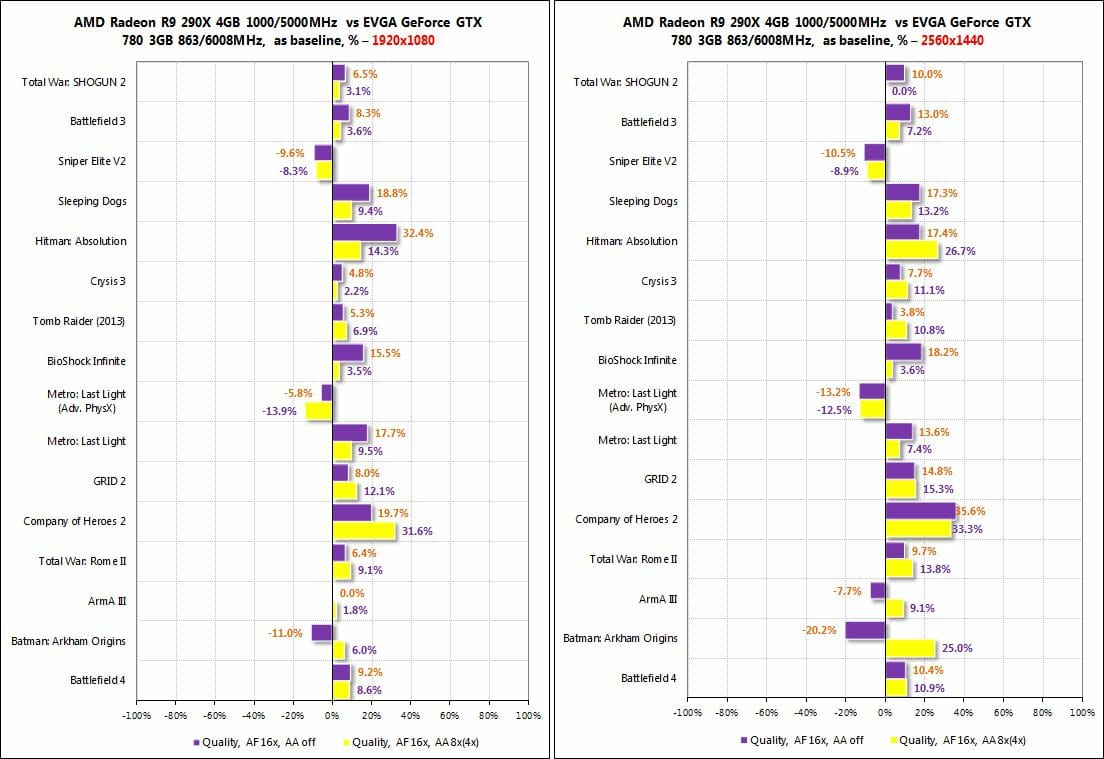
The GeForce GTX 780 wins in Sniper Elite V2, Metro: Last Light (with Advanced PhysX) and in Batman: Arkham Origins (without antialiasing). In the rest of the games the Radeon R9 290X is at least as good as the GeForce GTX 780 and even beats the latter in Sleeping Dogs, Hitman: Absolution, GRID 2, Company of Heroes 2, Total War: Rome II and Battlefield 4. The average advantage of the Radeon R9 290X across all the games is 7-8% without antialiasing and 6-10% with antialiasing.
As we mentioned in the Introduction, today even original GeForce GTX 780s with high-efficiency coolers and factory overclocking are considerably cheaper than reference Radeon R9 290X cards, so the new card should also be compared with the slightly more expensive GeForce GTX 780 Ti. Here are the diagrams:
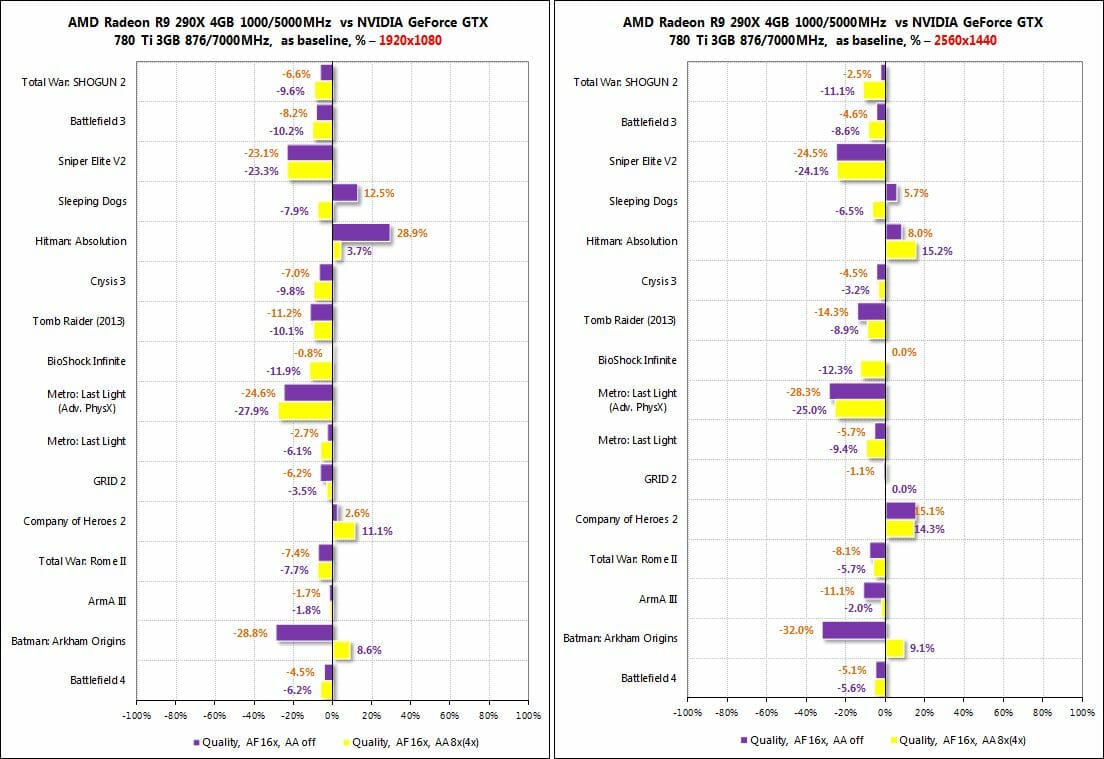
Nvidia wins this round. The Radeon R9 290X is only ahead in Hitman: Absolution, Company of Heroes 2, and in some test modes of Sleeping Dogs and Batman: Arkham Origins. In the rest of the games the GeForce GTX 780 Ti remains the fastest single-GPU gaming card.
The last pair of diagrams indicate the performance scalability of the Radeon R9 290X. We overclocked our sample’s GPU and memory by 130 MHz (13%) and 760 MHz (15.2%) and here are the benefits:
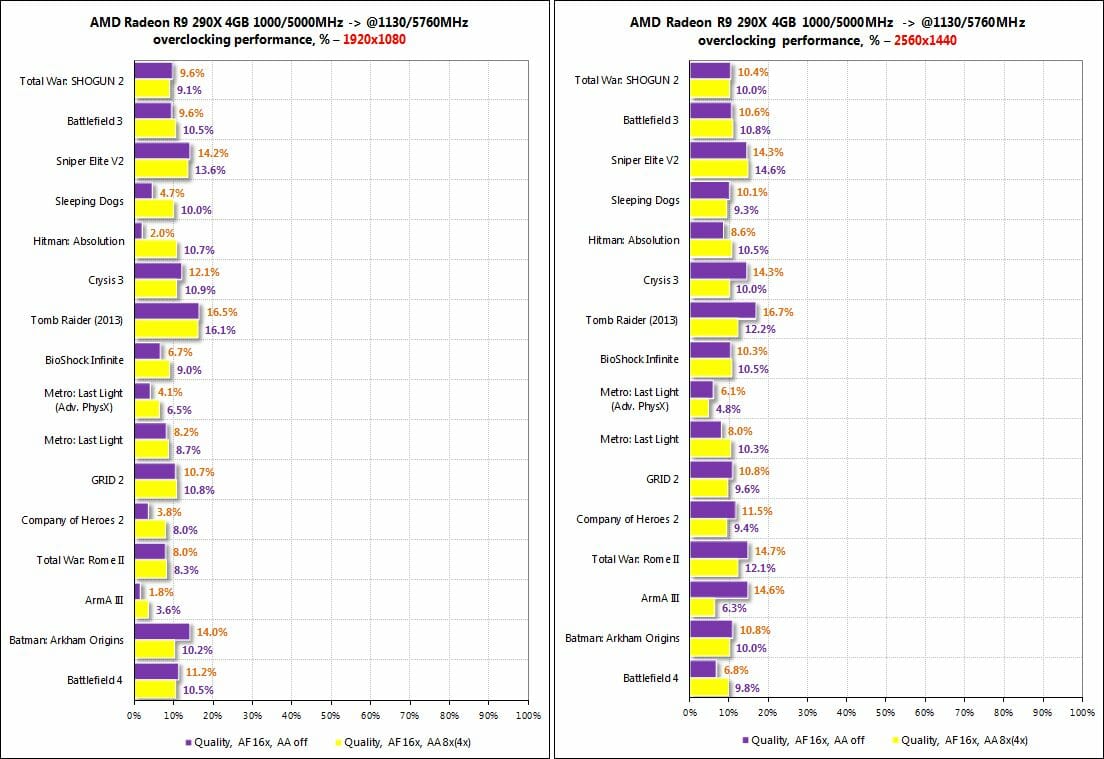
So the overclocked Radeon R9 290X is 9-10% faster at 1920×1080 and 10-11% faster at 2560×1440. That’s normal scalability for a top-end graphics card.
Power Consumption
We measured the power consumption of computer systems with different graphics cards using a multifunctional panel Zalman ZM-MFC3 which can report how much power a computer (the monitor not included) draws from a wall socket. There were two test modes: 2D (editing documents in Microsoft Word and web surfing) and 3D (the intro scene of the Swamp level from Crysis 3 running four times in a loop at 2560×1440 with maximum visual quality settings but without MSAA). Here are the results:
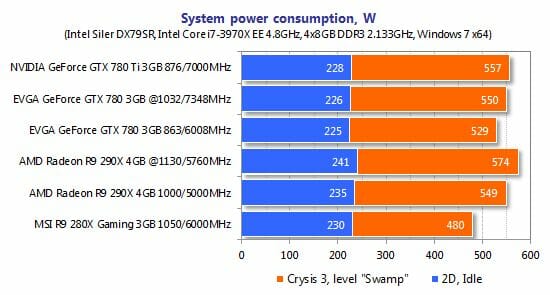
The peak power consumption of the Radeon R9 290X configuration is 69 watts (14.4%) higher compared to the MSI Radeon R9 280X Gaming and only 20 watts (3.8%) higher compared to the standard GeForce GTX 780. The GeForce GTX 780 Ti configuration needs about as much power as the AMD Radeon R9 290X. When the latter is overclocked, the computer’s power draw rises to 574 watts (by 4.6%). Any of these configurations can be powered by a 600-watt PSU.
Conclusion
At the time of its announcement in October 2013 the AMD Radeon R9 290X made a worthy opponent to the Nvidia GeForce GTX 780 despite all the problems with noise and overheat. However, Nvidia was quick to react by cutting the price of its single-GPU flagship (we don’t count the Titan in whereas the GTX 780 Ti wasn’t yet released then). Today, in early 2014, the reference Radeon R9 290X costs more than original GeForce GTX 780s. Even though it is faster on average, the small difference in performance doesn’t make up for the higher noise level and potential GPU frequency drops due to overheat.
If you want to buy a Radeon R9 290X, you should wait for original versions from first-tier brands as all of them have already announced their Hawaii XT based products. If priced lower than the GeForce GTX 780 Ti, they will be quite an attractive buy. We’ll test one such product very soon. We’re also preparing a review of the AMD Radeon R9 290 (without the “X”), so stay tuned to us in the new year!